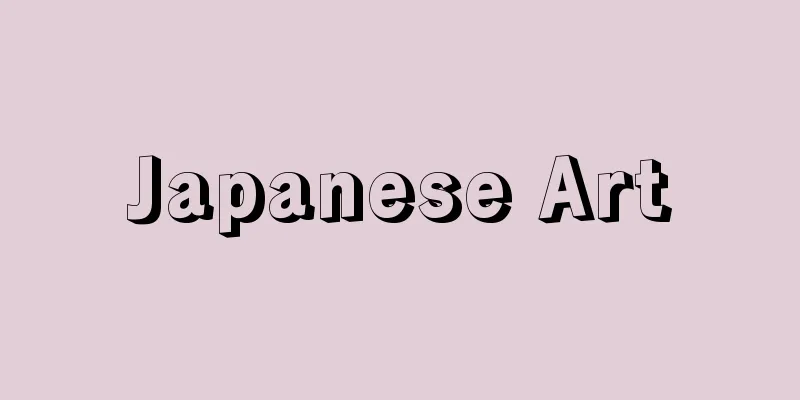Japanese Art

|
From prehistoric times to the historical period, Japanese art has absorbed art from China and Korea, and has developed and created a unique world of beauty while reflecting the trends of those art. This is largely due to the excellent aesthetic sense of the Japanese people and the natural environment that Japan enjoys. Since the early modern period, Japanese art has attracted interest from overseas, albeit in limited fields, but now there is a movement to grasp the overall picture of Japanese art in the world, and its characteristics and position have been deeply understood. Understanding Japanese art from such a broad perspective will be an important task in the future, but here we will overview the flow of Japanese art from ancient times to the present, and describe the trajectory of its development, focusing on sculpture, painting, crafts, etc. In addition, details are provided in the respective sections on "calligraphy," "ceramics," "dyeing and weaving," "gardens," "Japanese architecture," "shrine architecture," "Buddhist architecture," "Japanese swords," "Buddhist statues," and "Buddhist paintings." [Shinichi Nagai] PrehistoryDuring the Jomon period, people lived in pit dwellings and produced pottery for daily use, as well as clay masks and clay figurines that were thought to be used for magic. Many of the clay figurines were in the shape of women, and in these extremely primitive sculptures one can see the beginnings of a creative sensibility. Around 400 BC, the Yayoi period began, and the influence of continental culture began to spread throughout the country, slowly at first, but then more rapidly. Rice cultivation was introduced from the continent, and people began to live a life centered around agriculture. As a result, Jomon pottery lost its roughness and strong vitality, and began to change into more gentle shapes. When bronze and iron tools were introduced to Kitakyushu from the continent, Japan also produced bronze swords, bronze spears, bronze mirrors, and other items, but also made bronze bells, which are unique to Japan. Judging from excavated items, bronze bells are thought to have been made mainly in the Kinki region, but their purpose is unclear. However, the pictorial depictions of kesadasuki (a traditional Buddhist robe worn by a person wearing a kimono) and flowing water, small animals such as dragonflies, turtles, and waterfowl, and people hunting and dancing, show the high level of casting technology in the Yayoi period. During the Kofun period, most ordinary people still lived in pit dwellings, but the ruling class lived in stilt houses, with gabled or hipped roofs topped with katsuogi (a wooden beam) as a symbol of authority. Shrine architecture such as Ise Shrine and Izumo Taisha Shrine, which still preserve their ancient customs to this day, continue to convey the architectural style of the Kofun period. In addition, clay sculptures and haniwa (clay clay figures) were made as grave goods for the kofun. The haniwa include houses, household items, people, animals, and more, and while all are simple in expression, they capture the characteristics of their subjects well, making them valuable materials that tell us about life at a time when documents are scarce. The primitive paintings on the decorated kofun tombs in Kyushu also show the influence of continental wall paintings. Metal crafts showed remarkable development during the Kofun period, with engraving techniques beginning to appear on weapons, martial arts equipment, and accessories. Foreign patterns such as dragons, twin phoenixes, arabesque patterns, and palmette designs were applied using openwork and hair engraving techniques. Inlay techniques, in which gold and silver are fitted into other metal bases, and plating techniques also developed, and it is believed that the basic techniques of metalworking had become established in Japan by the Kofun period. [Shinichi Nagai] Asuka and Hakuho periodsIn art history, the Asuka period is broadly divided into two periods: the period from the official introduction of Buddhism to the Taika Reforms (645) is called the Asuka period, and the period after that up to the relocation of the capital to Heijō in 710 (the 3rd year of Wadō), is called the Hakuhō period. With the introduction of Buddhism, along with Buddhist scriptures, doctors of I Ching, calendars and medicine, monks, artisans for constructing Buddhist statues and temples, tile makers and painters were presented from Baekje, and with the emergence of a great leader named Prince Shotoku, Buddhist art made great strides from the 6th to 7th centuries, and these artisans played a major role in this development. [Shinichi Nagai] SculptureWith the construction of large temples one after another, the demand for Buddhist statues increased, and initially, they were produced using techniques and styles from the continent. The oldest Buddhist statue with a known production date is the Seated Shaka Nyorai (Shakanyorai zazo) at Asukadera Temple (606), which lost much of its original appearance due to a lightning fire during the Kamakura period, but is said to have been made by Tori Busshi. The next oldest work bearing an inscription is the Shaka Triad (Shaka Sanzon Statue) at the Golden Hall of Horyu-ji Temple (623), which is also a gilt bronze Buddha like the one at Asukadera, and was made by Tori Busshi. The Tori style is characterized by its frontal contemplation, apricot-shaped eyes, upward-facing lips, and symmetrical folds in the robes, and the Guze Kannon statue, the principal image of the Yumedono Hall of Horyu-ji Temple, follows this style. This statue is made from a single piece of camphor wood and is the oldest surviving wooden statue in Japan. Although it is also a wooden statue, the Baekje Kannon at Horyu-ji Temple, thought to have been made in the mid-7th century, has a dry lacquer coating on the surface, giving the statue an overall softer appearance. This Baekje Kannon goes a step further from the emphasis on frontality and bilateral symmetry seen in the Kondo Shaka Triad and Savior Kannon statues mentioned above, and also emphasizes lateral aspects, demonstrating the transition towards a more natural representation of the human body. One type of Buddhist statue that was popular during the Asuka period was the pensive half-seated statue. In the Korean peninsula, belief in Maitreya became popular in the latter half of the 6th century, and statues of Maitreya were made out of gilt bronze or stone, and as a result of this influence, Japan also produced some excellent works. The pensive half-seated Maitreya statue at Koryuji Temple in Kyoto is an example made from red pine, which was rare at the time when camphor was the norm for wood carvings, but a very similar gilt bronze statue exists in Korea, and is thought to have been made by a Buddhist sculptor from Baekje who came from Korea. The bodhisattva half-seated statue at Chuguji Temple in Nara, which is in a similar pose, is characterized by its own soft style that differs from both the Tori style and the Korean style. During the Hakuho period, the construction of temples and Buddha statues by the imperial family and powerful clans became even more popular, and Buddhist art made greater advances than in the previous period, with the construction of Fujiwara-kyo and the founding of Yakushi-ji Temple. Externally, exchanges with the Korean Peninsula became increasingly close, and with the dispatch of envoys to the Tang Dynasty, direct influence from the continent emerged, leading to the development of a bright and lively style of art befitting the name Hakuho. In terms of technique, clay statues such as the Maitreya Buddha at Taima-ji Temple in Nara were created, as well as brick Buddhas made from female prototypes and extruded Buddhas made by pressing a thin copper plate onto a prototype. Influenced by the early Tang Dynasty in China, many of these Buddhist statues from the Hakuho period have plump bodies and pure expressions, and this tendency can also be seen in gilt bronze Buddhas. The Yumechigai Kannon statue at Horyuji Temple is a good example of this, and is thought to have been made around the end of the 7th century during the late Hakuho period. Its human-like, childlike face and the elegant folds of its clothing are characteristic of this period. During this period, Buddhism spread to areas far from the Kinai region, and relics of this temple can be found all the way to the eastern part of Japan. [Shinichi Nagai] PaintingAmong the paintings from the Asuka period, there is the panel painting (Shashinshiko and Seshinmonge) of the Tamamushi Zushi (Tamamushi Shrine) at Horyu-ji Temple, which can be said to be the oldest artistic painting in Japan. This was painted as a design for a palace-style shrine, and in recent years, with the introduction of the murals of the Mogao Caves in Dunhuang, there has been a wealth of information available for understanding this panel painting. In the 6th and 7th centuries in the Western Regions, Buddhist paintings on the themes of tales of the original life and the life of Buddha were produced in great numbers, and the Tamamushi Zushi panel paintings probably reflect this trend on the continent. However, there is a big gap between the two styles of painting, with the Mogao Caves' painting style being rough and powerful, while the panel paintings are refined and possess a deep flavor. Three successive vertical scenes are rhythmically painted, and detailed depictions of nature are arranged around them, showing that Japanese painting developed through a deep connection with nature. Few Hakuho paintings remain, but the murals in the Golden Hall of Horyu-ji Temple and the Takamatsuzuka Tomb murals, discovered in 1972 (Showa 47), remain. The Golden Hall murals of Horyu-ji Temple were damaged in a fire in January 1949 (Showa 24), but the smaller walls were spared. The murals are painted with a flexible vermilion line that is neither thick nor thin, called tessen-ga (iron painting), and the shading is used to express the volume of the body. With precise technique and clear composition, the Buddha is depicted as an ideal human figure. In contrast, the Takamatsuzuka Tomb murals are noteworthy because they are not Buddhist paintings, but rather deal with secular themes. The color treatment and group composition of the depictions of the customs and customs of the male and female figures are reminiscent of the origins of later Yamato-e painting. [Shinichi Nagai] CraftsAsuka period metalwork items bearing date inscriptions include the gilt bronze halo inscribed with the year of the Tiger (594) that was donated to Horyu-ji Temple, the oldest temple bell in Japan at Myoshin-ji Temple in Kyoto and the temple bell at Kanzeon-ji Temple in Fukuoka that are inscribed with the year of the Dog (698) from the Hakuho period, and the gilt bronze openwork kanjo banner at Horyu-ji Temple. The kanjo banner is a type of solemn item, and is excellent in both design and technique, with gilded metal plates engraved with openwork images of flying celestial beings dancing in fluttering heavenly robes and decorated with flying clouds and palmette patterns. In terms of dyed and woven textiles, there are remains of the Tenjukoku Embroidery Scroll (622) at Chuguji Temple. It was embroidered to console the spirit of Prince Shotoku, and it is interesting that it appears to have depicted the customs of the time. [Shinichi Nagai] Nara periodIn art history, this period is also known as the Tenpyo period, and refers to the approximately 80 years between the relocation of the capital to Heijo-kyo in 710 (Wado 3) and the relocation of the capital to Heian in 794 (Enryaku 13). During this period, the Ritsuryo system was established and the bureaucratic system was developed. In particular, during the Tenpyo period (729-749) of Emperor Shomu, prosperous Tang culture was introduced by Japanese envoys to the Tang Dynasty, and in response, art rooted in Japanese culture flourished in all fields. The consecration of the Great Buddha of Todaiji Temple in 752 (Tenpyo-Shoho 4) can be said to be the very symbol of this era. [Shinichi Nagai] SculptureIn 741 (Tenpyo 13), when the construction of the palace and government offices in Heijo-kyo was completed, Emperor Shomu issued an imperial decree to build provincial temples and nunneries throughout the country. Construction of the Great Temple of Todaiji Temple began in 745. This led to a boom in the world of Buddha sculpture, with government-run Buddha sculpture workshops such as the Todaiji Construction Office established, where skilled craftsmen could demonstrate their skills under the guidance of skilled instructors, and Japanese sculpture reached a classical perfection during the Tenpyo period. However, the original Great Buddha, the greatest and largest monumental presence that is said to have been made using all the country's copper, was later lost in a fire during the war, and only a trace of it remains in the Buddhas of the Lotus Treasury World engraved on the lotus petals of the pedestal. Representative works of Tenpyo sculpture that still exist include the clay statues of the Five-story Pagoda of Horyu-ji Temple, the Yakushi Triad in the Golden Hall of Yakushi-ji Temple, the six statues of the Ten Great Disciples of Kofuku-ji Temple, and the statues of the Eight Deities of the Eight Deities of the same temple. Of these, the Ten Great Disciples and the Eight Deities of the Eight Deities of Kofuku-ji Temple, made in 734 (Tenpyo 6) and made of dry lacquer, take advantage of the twisted plasticity of the clay, and have more familiar faces that are more suited to Japanese tastes than the clay statues of the Five-story Pagoda of Horyu-ji Temple, and express subtle psychological states. The dry lacquer statues are roughly formed from clay, and then linen cloth is pasted on top of each other with lacquer to fix them in place, and the clay inside is scraped out, making them like papier-mâché statues, and the surface is smoothed with lacquer to give them a unique softness. Other works made using this method include the Fukukenjaku Kannon standing statue and attendant statues in the Hokke-do Hall of Todai-ji Temple, and the Ganjin statue at Toshodai-ji Temple. Additionally, clay statues include the Vajrapani statue and the Nikko and Gakko Bodhisattva standing statues in the Hokke-do Hall of Todai-ji Temple, the Four Heavenly Kings statues at Todai-ji Temple's Kaidan-in Temple, and the Twelve Heavenly Generals statues at Shin-Yakushi-ji Temple, all of which are works of a high standard. In the mid-Tenpyo period, woodcarving was revived, and a group of works such as the Denyakushi Nyorai statue at Toshodaiji Temple and the Yoryu Kannon statue at Daianji Temple have stately physiques and varied drapes in their clothing, expressing a sense of weight and movement that differs from the gentle style of the earlier period. In the second half of the 8th century, wooden-core dry lacquer statues, which could be described as a hybrid of woodcarving and dry lacquer, became popular, and representative works of this include the Eleven-Headed Kannon statue at Shorinji Temple in Nara and the Thousand-Armed Kannon statue at Toshodaiji Temple. [Shinichi Nagai] PaintingThe Taima Mandala, or Contemplation of the Muryoju Sutra, at Taima Temple is a tapestry depicting the Amida Pure Land. It was originally nearly four meters in size, but the painting incorporates depth and perspective, demonstrating the relationship between Tenpyo painting and Tang painting. The Yakushiji Temple statue of Kisshoten is small, but with its delicate line drawings and exquisite coloring, it can be said to be a Tang-dynasty-style genre painting of a beautiful woman in the form of a Buddhist painting. The influence of the Tang style can be seen not only in Buddhist paintings, but also in paintings for interior decoration. The Shosoin treasures include many paintings on furnishings, musical instruments, and crafts, many of which were imported from the continent. Recent investigations have confirmed that the Torigeritsujo folding screen was made in Japan, but the original bird feathers that were pasted on it have peeled off, revealing the ink lines of the sketch, giving it the feel of a light-colored ink painting of a beautiful woman. The Hemp Cloth Bodhisattva, also a Shosoin treasure, is a bodhisattva above the clouds, and is depicted with a sense of dynamism as her heavenly robes flutter. These works incorporate the style of Chinese Tang-dynasty painting, but the excellent techniques that were mastered show that the foundation was laid for the development of more Japanese-style paintings. [Shinichi Nagai] CraftsThe Shosoin treasures are central to the crafts representative of the Tenpyo period. Some were brought over from China, but the majority were made in Japan. Famous metalwork items include an octagonal mirror with bird, animal and flower motifs, copper and silver incense burners, and gold and silver flower-shaped containers, all of which are elegantly designed using openwork and kick carving techniques. Buddhist implements include banners, floral garlands, bowls, water jars, and incense burners with handles. The gilt bronze octagonal lantern in front of the Great Buddha Hall, which was made when the Great Buddha was consecrated, is also an excellent casting. Lacquerware also made great strides under the influence of China, with items being made using techniques such as plain patterning, mother-of-pearl inlay, mitsudae, gold and silver painting, and makie. In pottery, glazed pottery called Nara Sancai, which is a combination of Sancai and two-color ware modeled after Tang Sancai, is produced. Most of the dyed and woven textiles have been passed down in Horyuji Temple and Shosoin Repository. Some of the rags were made on the continent, and many were made in the first half of the 8th century, making them extremely valuable in art history. They were woven as 'choyofu' (a traditional cloth used for decoration) at the time, and some have inscriptions of places or people's names. Woven textiles include plain silk, twill, ramie, warp brocade, weft brocade, and tsuzure, while dyed textiles include three types of 'roketchi' (paper suri-e), 'kyoketchi' (paper suri-e), and 'koketchi' (paper suri-e), and it can be said that the basic dyeing and weaving techniques were all in place at this time. [Shinichi Nagai] Heian PeriodThis was an era of aristocratic culture that lasted for about 400 years from the transfer of the capital to Heian (794) to the fall of the Taira clan (1185). During this period, the Shingon Esoteric Buddhism brought from China by Kukai and the Tendai Esoteric Buddhism of Saicho had a major impact not only on the Buddhist world but also on the art world. When the transfer of culture from the continent came to a halt with the abolition of the Japanese missions to Tang China, the energy accumulated up until then allowed the country to form its own unique culture, which blossomed into a dynastic culture. However, a fire in Nara in 1180 (Jisho 4) buried the elegant and luxurious aristocratic culture, and also signaled the end of the ancient era. [Shinichi Nagai] SculptureIn sculpture, the early Heian period is called the Kōnin/Jōgan style, and the later Fujiwara style, but the Kōnin period (810-824) saw a noticeable anti-classical expression in contrast to the classical style perfected in the Tenpyō period. Rather than harmonious external beauty, they sought the inner spirit and religiosity of humans, and sometimes attempted to create superhuman expressions accompanied by bold deformations. As a result, statues with a sense of weight that overwhelms the viewer were created, such as the honpa-style robe patterns, esoteric Buddhist statues with many faces, eyes, and arms, and the Acalanatha Kannon statue at Toshodaiji Temple. The style is heavy and robust, full of a sense of life. There was also a change in the materials used. The production of gilt bronze Buddhas, clay statues that require specialized skills, and dry lacquer statues that require large amounts of expensive lacquer went into decline, and wooden statues became the norm. Examples include the Yakushi Nyorai statue at Shin-Yakushiji Temple in Nara, the Nichira statue at Tachibana-dera Temple, the Eleven-Headed Kannon statue at Hokkeji Temple, and the Yakushi Nyorai statue at Jingo-ji Temple in Kyoto, and the statues at Hokkeji Temple and Jingo-ji Temple in particular make use of the beauty of the wood's surface. In the Jogan period (859-877), the number of esoteric Buddhist statues increased with the establishment of Shingon Esoteric Buddhism and Tendai Esoteric Buddhism, and mystical Buddhist statues with many painted pictorial elements began to be created. The Nyoirin Kannon statue at Kanshinji Temple in Osaka is an example of this. During this period, the powerful look of the Kōnin period disappeared, the wave-like folds of the robes became more formalized, and the face took on a Fujiwara-style appearance with slightly downcast eyes. Examples include the Shaka statue in the Golden Hall of Murō-ji Temple in Nara and other statues. In the 9th century, Buddhism spread to the provinces, and the construction of temples and Buddha statues became more popular, resulting in many excellent, lively Buddhist statues in the provinces, such as the Yakushi Triad at Shojō-ji Temple in Fukushima and the Yakushi statue at Kokuseki-ji Temple in Iwate (inscribed with the year Jogan 4). Influenced by Buddhist sculpture, statues of deities were also created. The three statues of Sogyo Hachiman, Empress Jingu, and Nakatsuhime at Yakushiji Temple, and the male and female deity statues at Matsunoo Taisha Shrine in Kyoto are all thought to be works from the Kanpyo period (889-898). In the second half of the 10th century, the power of the Fujiwara regents grew, and as the number of temples and Buddha statues built at their request increased, excellent Buddhist sculptors established their own workshops and created Buddhist statues with the help of many craftsmen. Jocho is a Buddhist sculptor representative of this Fujiwara period. The Phoenix Hall of Byodo-in Temple in Uji was built in 1053 (Tenki 1) at the request of Fujiwara no Yorimichi, and the principal image of the statue, an Amida Nyorai statue, is made of inlaid wood and was created by Jocho. The refined and well-balanced form and harmonious appearance well reflect the tastes of the time, and more than 40 cloud-based Bodhisattva statues, made of warihagi wood, are hung on the nageshi (rails) inside the hall. Jocho's lineage split into various schools, including the En school, the In school, and the Nara Buddhist sculptors. At the end of the Fujiwara period, a brilliant Buddhist sculptor appeared in Nara, and in 1176 (Angen 2), he created the Dainichi Nyorai statue at Enjoji Temple in Nara. This was the work of Unkei in his younger days. It foretold the arrival of a new era, different from the Jocho style that had existed up until then. [Shinichi Nagai] PaintingThere are few remains from the early Heian period (until 894, when the Japanese missions to Tang China were abolished), but the Karae style of painting was still dominant, as can be seen from the fact that Kukai brought back statues of the Five Shingon Patriarchs painted by Li Zhen, a representative Tang painter, and later added statues of the Second Patriarch in Japan following the same style (these are the statues of the Seven Shingon Patriarchs at Toji Temple). However, in the later Fujiwara period, painting broke away from the continental style and began to flower in a style unique to Japan. Among the Buddhist paintings from the Fujiwara period is the Ryogai Mandala, a mural on the first floor of the Five-Story Pagoda at Daigo-ji Temple, dating from 951 (Tenryaku 5), which shows an overall gentler style than the religious paintings of the previous era, including its lines. In the 11th century, paintings became more Japanese-style, as can be seen in the door painting of the Phoenix Hall at Byodo-in Temple in Uji, completed in 1053. Then, in the second half of the 11th century, works such as the Buddha's Nirvana at Kongobuji Temple in Wakayama, which is dated 1086 (the third year of Otoku), the statue of Jion Daishi at Yakushi-ji Temple, the statue of Tendai shoso at Ichijo-ji Temple in Hyogo, and the Blue Acala at Shoren-in Temple in Kyoto appeared, and with their soft lines and vivid colors, they clearly demonstrated a new Japanese style that had broken away from the Chinese style. Furthermore, in the 12th century, Buddhist paintings began to emphasize splendor and added fine detail, as seen in the statues of Fugen Bodhisattva and Kujaku Myoo at the Tokyo National Museum, the Twelve Devas at Toji Temple (completed in 1127), the Shaka Nyorai statue at Jingo-ji Temple, and the Amida Shoju Raigo painting at Mount Koya. Alongside the Buddhist paintings mentioned above, many excellent secular paintings were produced during this period. It is known from historical documents that the so-called Kara-e paintings, which depicted Chinese customs and landscapes based on paintings from China, were popular among the imperial court and nobles. However, this did not satisfy the Japanese aesthetic sense, and a demand arose for Japanese-style paintings that would capture Japan's nature and customs. This was Yamato-e (also called Yamato-e or Wa-e), and paintings of the four seasons and famous places began to be produced using this method around the end of the 10th century. The landscape screen at Kyoto National Museum has Bai Juyi, originally a subject of Kara-e paintings, as its main subject, but with the exception of the figures, it shows the tendencies of Yamato-e, which is interesting as it shows a concrete trend in painting from the end of the 11th century to around the 12th century. During this period, excellent narrative literature appeared one after another, and scenes from the literature were depicted in pictures that could be kept close at hand for appreciation. The illustrated Tale of Genji (first half of the 12th century) is a representative example of this, and taking advantage of the limitations of the illustrated scroll format, various ingenious designs were used in the composition of the picture, such as the open-air stall. The simplified depiction of characters, known as the "hikimekagihana" style, and the characteristic lyricism and decorativeness are known as "onnae" (women's paintings). In contrast, works such as "Shigisan Engi" and "Ban Dainagon Ekotoba" are known as "otokoe" (men's paintings), with dynamic line drawings and scene developments based on tales and legends. Other examples include the white-drawn "Choju Jinbutsu Giga," "Jigoku Soshi" and "Gaki Soshi" depicting the six paths of life, and "Thirty-six People Collection," which aimed for the beauty of the combination of calligraphy and painting. In addition, as copying sutras to pray for the Pure Land became popular, beautifully decorated sutras, with their writing paper and endpapers decorated with the utmost care, were dedicated to shrines and temples. The most famous is the "Heike nokyo" (Heike sutra) at Itsukushima Shrine by the Heike clan. [Shinichi Nagai] CraftsMetalwork representative of the Heian period includes Buddhist altar implements and Japanese mirrors. Many temple bells bear dates, such as the temple bell of Jingoji Temple, inscribed with the year 875 (the 17th year of the Jogan era), and the temple bell of Eisan Temple, inscribed with the year 917 (the 17th year of the Engi era). There is also the lantern door of Kofukuji Temple, inscribed with the year 816 (the 7th year of the Kōnin era), with its inscription cast in relief. In addition, the flower garland of the Golden Hall of Chusonji Temple, with its openwork carving of the Hosōge pattern, and the sutra box containing the Heike nokyo sutra at Itsukushima Shrine, are examples of the tastes of the aristocrats of the time. Mirrors also depict flowers and birds in a delicate way, and the arabesque double phoenix mirror discovered inside the womb of the Yakushi Nyorai statue at Shitennoji Temple in Mie Prefecture shows the style of Japanese mirrors from the Fujiwara period. In the latter part of this period, the samurai rose to power, and many pieces of armor remain, such as the navy blue lacing armor worn by Taira Shigemori at Itsukushima Shrine and the red lacing armor worn by Hatakeyama Shigetada at Mitake Shrine in Tokyo. In the mid-Heian period, lacquerware perfected advanced techniques such as polished makie and gradation maki to create color effects, and further combining makie with mother-of-pearl to create a harmony between gold, silver, and shell. These were used for furnishings, Buddhist altar implements, and architectural decoration, and the ancient sacred treasures of Kasuga Taisha Shrine in Nara, also known as the Shosoin Repository of the Fujiwara period, include excellent pieces such as a makie koto (Japanese harp) and a tweezer-shaped sword with gold and mother-of-pearl inlay. As for ceramics, ash-glazed pottery produced at high temperatures in the foothills of Mt. Sanage in Aichi Prefecture was distributed throughout the country, and green-glazed pottery, which followed the Nara Sansai style, was also produced around this time. In the late Heian period, the Atsumi kilns and Tokoname kilns were built. Few dyed and woven items remain, but it is noteworthy that the technique of fusenryo, which makes patterns stand out, was developed on aristocrats' costumes such as sokutai (traditional Japanese formal robes), mo (skirts), and karaginu (traditional Japanese robes), and that delicate dyeing techniques, said to amount to over 100 colors, were developed through kasane irome (layered colors), which creates variation through the overlapping of colors. [Shinichi Nagai] Kamakura and Muromachi PeriodsThe art of Kamakura began with the reconstruction of Todaiji Temple and Kofukuji Temple in Nanto, which had been destroyed by fire during the Jisho War (1180). The model used at that time was not the previous Fujiwara period, but the classical art of the Asuka and Tenpyo periods. This kind of renaissance phenomenon is most evident in the fields of architecture and sculpture. The culture of the Song dynasty, especially Zen Buddhism, was a major spiritual stimulus, and had a major influence on painting and calligraphy throughout the Muromachi period. Furthermore, the emerging momentum that new sects of Buddhism, such as Jodo Shinshu, Jishu, and Nichiren, which were born during the Kamakura period, had on people was also reflected in the arts. In the following Muromachi period, the Onin War (1467-1477) brought about a great change in culture, and in art as well, there are remarkable differences before and after the war. Zen art, which had flourished mainly in the Five Mountains of Kyoto and Kamakura, was completely entombed by the Onin War, and a new art style that made use of Japan's ancient traditions began to emerge. It is noteworthy that artistic activities began to take place in various regions far from Kyoto, such as in the paintings of Sesshu and Sesson, that art, which had previously been reserved for a select few rulers, gradually spread to a wider range of classes, and that the foundations for the rise of the next early modern culture were built as a result. [Shinichi Nagai] SculptureThe Nara Buddhist sculptor Kōkei and his disciples were active in the Nara reconstruction project. Kōkei's son Unkei demonstrated his keen powers of observation in the many Tenpyo Buddha statues he had seen and repaired in his youth, and this became the basis for him to establish a new style that combined the realism of Tenpyo sculpture with the weightiness of the early Heian period, such as the statues of Asahara and Vasubandhu (1212) at Kōfuku-ji Temple and the statue of Seitaka-doji at Kongōbu-ji Temple. After Unkei's death, his eldest son Tankei inherited his father's style but restrained the bold expressions, leaving behind works that exude the elegance of the capital, such as the Thousand-Armed Kannon statue, the principal image of the Sanjūsangen-dō Hall. His third son, Koben, created the Tendouki and Ryutouki statues for Kofuku-ji Temple, and his fourth son, Kosho, created the statue of Kuya Shonin for Rokuharamitsu-ji Temple in Kyoto. In terms of materials, bronze and clay statues, which were not often seen during the Heian period, made a comeback. Copper production increased in various regions, and the Great Buddha of Todaiji Temple was restored, as well as the statue of Amida Nyorai at Kotoku-in Temple in Kamakura, known as the Great Buddha of Kamakura, was created during the Kencho era (1249-1256). One of the characteristics of this period is the large number of excellent portrait sculptures, and in Zen Buddhism portraits of masters were actively created. Also, the secular statues of warriors, such as the statue of Uesugi Shigefusa at Meigetsu-in Temple in Kanagawa Prefecture, show the realistic tendency of Kamakura sculpture. In the latter half of the Kamakura period, Buddhist sculpture rapidly declined, and no new styles were born even in the Muromachi period. The Tsubai Butsujo, a small school of the Kei school, was active and created statues for Gangoji Temple and Hasedera Temple. During this period, Noh theater became popular, and Noh mask makers known as "menuchi" left behind many fine pieces. [Shinichi Nagai] PaintingThe group image, reality and speed seen since the end of the Fujiwara period are emphasized, and one of them is a raigo diagram that connects the present and the afterlife. The Yamagoshi Amida map at Zenrinji Temple in Kyoto is depicted with a realistic brushwork of Amida appearing on the mountain, and the 25 Bodhisattvas at Chionin Temple in Kyoto (Hayaraigo) is full of speed. Portraits were also frequently painted. The images of Minamoto Yoritomo, Taira Shigemori and Fujiwara Mitsuyoshi from Jingoji Temple in Kyoto are said to be the brushwork of Fujiwara Takanobu, who was said to be a master of similar images, and they vividly capture the individuality of each of the subjects. Takanobu's son Nobuzane is also good at similar images, including Emperor Gotoba (1221) at Minase Shrine in Osaka, "The Satsuki-Kaisho" and "The Satake 36 Poetry Picture Scroll." After Nobumi, there are statues of Emperor Hanasou no (Chofukuji Temple, Kyoto, 1338), and statues of Myoe Shonin at Kozan Temple in Kyoto. Picture scrolls became even more popular in the past. In addition to literary works such as the "Sui Shikibu Diary Picture Scroll" and "Pillow Books" many war scrolls were also made, and "Heiji Tale Picture Scroll" and "Moko Invasion Picture Scroll" are elaborate expressions and are valuable as a record of war records. A series of shrines and temple auspicious stories and legends of high monks have been created one after another, and there are also "Kitano Tenjin Engi" and "Ippen Shonin Picture Scroll". In the late Kamakura period, common people like "Obusuma Saburo Picture Scroll" and "Tohokuin Artisan Uta Awase Picture Scroll" appeared, which eventually unfolded into the Otogizoshi of the Muromachi period. Song's ink paintings were established in Japan as the second Tang painting, with landscape paintings and flower and bird paintings made using the extra techniques of Zen monks such as Baiyun Eixiao and Issan Ichinei. During the Muromachi period, specialist artists such as Mincho and Shubun were active, and poetry and ink paintings were created, combining poetry and ink paintings with ink paintings by Zen monks. At the end of Muromachi period, local paintings were also active in the local painting world, and Sesshu, a monk from Suo (Yamaguchi) completed a unique landscape painting with solid construction and reality, and Yukimura, who was originally from Hitachi (Ibaraki), was active in the eastern part of the eastern part of the country. Meanwhile, in Kyoto, Kano Masanobu became the founder of the Kano school, using the Kara and Yama and painting techniques. Motonobu, a son of Masanobu, incorporated ink-scratch screens and Min-spark paintings into Yamato paintings, creating a disability screen style as a decorative painting for Shoin architecture, which eventually developed into a great future as a Kinpeki disability screen painting in the next Momoyama period. [Shinichi Nagai] CraftsReflecting the samurai culture, the production of weapon swords was thriving, and many famous swords were produced mainly on the so-called five legends of Yamato, Yamashiro, Bizen, Mino, and Sagami. In particular, Masamune Soshu was considered the model for swordsmanship in future generations. In sword equipment, Goto Yujo, who served Ashikaga Yoshimasa, was famous, and he was a representative metalworker of the Muromachi period. During the Muromachi period, tea ceremony was popular, and Tenmyo in Ashiya in Chikuzen (Fukuoka Prefecture) and Sano (Tochigi Prefecture) are famous as the production area of tea ceremony kama. Lacquer crafts have been popular since the previous era, but in the Kamakura period, Kamakura carvings imitating the techniques of the Ming Dynasty and Black-black were created, and in the Muromachi period, Negoro lacquer was started, which was not decorative. [Shinichi Nagai] Momoyama periodになったんです。 English: The first thing you can do is to find the best one to do. On the other hand, a state of silence was sought in the small spaces of the Soan-style tea room, and light-hearted Sukiya architecture was also created. This seemingly contradictory tendency between gorgeousness and Wabito shows not only the Momoyama culture, but also the bilateral nature of Japanese art from the early modern era. From Tensho to Keicho, Toyotomi Hideyori repaired and built various Buddhas of Hokoji Temple and Toji Temple, and in the early Edo period, the Edo Shogunate ordered various daimyos to build Nikkorin-Ou Temple and Kanei Temple. These Buddhas were created by Buddhist sculptors from traditional Buddhist temples, but the energy that was seen in the early Kamakura period was not finally revived, and they ended up mischievously imitating the Buddha statues of the early period, and the sculptures continued into the Edo period. [Shinichi Nagai] PaintingCompared to the sculptures that have faded, paintings have entered the golden age of disability screens with gold and blue paint, known as dark paintings, and have created the most spectacular, bright, and brilliant style in Japanese painting history. Kano Eitoku was the leader of this early Momoyama painting. He showed his talent to surpass his grandfather Motonobu in the sliding doors of the plum and water birds at the guest hall of the Jukoin Temple, and the Rakuchu Rakugaizu screens lively depicting the state of Kyoto, which was becoming more and more modern as an early modern city, using a detailed brush. In his later years, he formed a large screen that overwhelms the viewers, such as those seen on Karajishi and Hinoki screens. Next were the sons of Eitoku and his disciple Sanraku who were active in the Keicho period (1596-1615). Mitsunobu, a son of Eitoku, and his disciple Sanraku, who used Yamato's painting techniques, created paintings of flower and wood drawings for Onjo Temple Gakuin, and Sanraku's masterpieces include the peony drawings, red plum drawings, and the pine hakaku paintings of the Daikaku Temple. Other than the Kano school, the Hasegawa Tohaku paintings of Chishakuin, the pine forest drawings, and Kaiho Yusho. Tomomatsu was born in the warlord, and has a deep knowledge of Zen, and is full of spirit, like the ink-obstructed screen paintings of Kennin Temple Honbo. Momoyama's current affirmation is fully demonstrated in the customs paintings such as the Floor-Underground Flowing Screen and the Floor-Kokuni Festival Flowing Screen. Another aspect of the customs of the time is the Nanban folding screen. Foreign trade became popular, and Nanbans, mainly Portuguese, came to the arrival of the Portuguese, and their European customs captured the curiosity of the people. Western-style paintings began when the Jesuits taught Western painting techniques at a seminary (seminaria) established in Kitakyushu, and foreign-loving screens were created. [Shinichi Nagai] CraftsThe magnificent architecture of the castle and Shoin construction resulted in the development of fittings and fittings, and the pull handles and nail-catching nails were decorated with transparent carvings and patterns. Inner sword fittings and inlaid tuna were also popular to match the samurai's gorgeous tastes, and the Goto family of generations waving their arms. Makie extends to the interior of the castle, and the Kodaiji Temple Makie is a product of the Hideyoshi couple's love for them, and is a masterpiece that represents Momoyama's lacquer crafts. With the excellent leaders of Sennorikyu and Furuta Oribe, the tea ceremony became a booming trend, and for this purpose, Hanaike, Mizusashi, and Rakuchawan, a tea ceremony specialist. Furthermore, the potter brought in by Hideyoshi's invasion of Korea opened kilns such as Takatori, Hagi, Satsuma, and Karatsu, making a great contribution to pottery production. Many luxurious masterpieces were created, such as tsujigahana dyeing, which makes full use of the techniques of sewing, embroidery, and surihaku, making use of the techniques of stitching and surihaku. [Shinichi Nagai] Edo periodArt history deals with the Kanei (1624-1644) and the Meiji Restoration (1868). Until the late 17th century, art was in the aftermath of Momoyama culture, but in the Genroku period (1688-1704), the cultural leaders moved from the ruling class to the Kamigata, which had accumulated wealth and townspeople in Edo. The gates to the West were closed due to the isolation of the country, but the paintings, crafts, and books by the Ming and Qing Dynasty were popular, and the great rise of Nankai and Chinese poetry were seen. Art during the Edo period was characterized by popularization, reflecting the times, and the energy of the common people cultivated by this was a factor that promoted the modernization of the Meiji period. Although sculptures have declined even further than their previous generations, works by the monks Enku and Mokujiki, who are not specialized sculptors and belong to heresy, have been discovered one after another from all over the country in recent years, attracting the interest of modern people. From the end of the Edo period to the Meiji period, gechou (such as Nezuki) became more popular, and fine techniques were used to utilise pet tools that had left religious subjects. However, in terms of architecture, the Katsura Imperial Palace and Shugakuin Imperial Palace create a typical Japanese beauty, in which gardens and architecture blend together, and in contrast to this, a gorgeous mausoleum like Nikko Toshogu Shrine was also carried out, and many remain today. [Shinichi Nagai] PaintingThere is little to see in Buddhist paintings, and Edo paintings are concentrated in Yamato, Nanga, and customs. In the Momoyama period, the Kano school, which formed the foundations of this work with Eikoku and Sanraku, came out and created a new style of ink painting, but eventually resided in the position of the Edo Shogunate's official painter and formalized his style, and the Tosa school was in the position of the elusive azukari of the court, and only traced the ancient styles of Yamato painting, and did not experience any new winds. Rather, Kusumi Morikage and Hanabusaichou, who were on the sidelines, established a unique style of painting. It was the painters of the resident fields who incorporated the traditions of the Kano and Tosa factions and created their own unique style of painting. Tawaraya Sotatsu began his activities in the Momoyama period, and with his bold screen composition of gold, silver, mud paintings, colored paper, and fan surfaces, he created his own unique world of painting, as seen in his masterpieces' dance drawings and wind gods and thunder gods screens. Then, Ogata Korin was born in Kyoto, and with his design sense cultivated through dyeing and weaving, he reached a different world of decorative paintings than Sotatsu. The Kakitsubata folding screens and red and white plum blossom folding screens are his masterpieces as well as masterpieces of Edo painting. Korin's younger brother is the ceramic artist Ogata Kenzan. Next, Hishikawa Moronobu, who is said to be the founder of ukiyo-e, appeared as the author of the illustrations. Ukiyo-e has become a hugely rich expressive power through hand-painted handwriting, and multicolored printing, which was developed with the cooperation of carvings and printmakers. The artists have produced many ukiyo-e artists, including Suzuki Harunobu, who created Nishiki-e, Torii Kiyonaga from the Tenmei period (1781-1789), Kitagawa Utamaro, who came up with a new style called Ookubie, Toshusai Sharaku, who painted a unique close-up drawing of actors, and Katsushika Hokusai and Utagawa Hiroshige, who are the world-renowned for their landscape paintings, and many other ukiyo-e artists, including Katsushika Hokusai and Utagawa Hiroshige, who are a major source of Edo art. Nanga was born in accordance with the rise of Confucianism, the basis of the Bunji policy of the Edo Shogunate. It combined the style of Nanshuga painting and the philosophy of literary painting, achieving a unique development in Japan. Ikenotaiga and Yosabuson were representative painters. If Nanga painting was meticulous, it was Maruyama Okyo who focused on sketching, and he trained many disciples to establish the Maruyama school. In 1720 (Kyoho 5), when the 8th shogun Tokugawa Yoshimune lifted foreign books other than Christianity, interest in Western-style paintings without religious colors grew again, and under the direction of Hiraga Gennai, Akita Ranga, a blend of Japanese and Western styles, occurred in the Akita domain. Influenced by this, Shibakokan produced the first copperplate prints in Japan. Aododa Denzen, who outweighed the copperplate prints, depicted famous Edo sites, and left behind a major oil painting, a folding screen of Mt. Asama. Other exceptional painters from the late 18th and early 19th centuries include Ito Jakuchu, Soga Shohaku, Urakami Gyodo, Aoki Kiryo, and Tanomura Takeda. Tani Buncho established the so-called Karasu Bunche style, and Watanabe Kazan, the most outstanding of Bunche's disciples, adopted Western-style techniques, leaving behind excellent portraits like Takami Senseki statues. In 1815 (Culture 12), Sakai Hoichi (Sakai Hotsu) held the 100 Years of Korin, aiming to revive the Korin style. The summer and autumn grass screens clearly show Hoichi's delicate lyricism. [Shinichi Nagai] CraftsMomoyama Makie was created by Honami Koetsu, and by inheriting this, Ogata Korin produced masterpieces such as the Yahashi Makie Mother-of-pearl inkstone box (Shimakiera Denszuribako). In 1637 (Kanei 14), when Chiyohime, the eldest daughter of Shogun Iemitsu, married into the Owari (end) Tokugawa family, the Hatsune Makie wedding furnishings well represent the characteristics of Makie in the Edo period. In pottery, the first porcelain was made in Arita (Saga) by Li Sanpei, who had been naturalized from Korea in 1616 (Genwa 2), and in the end of Kanei, Sakaida Kakiemon successfully fired red-eed porcelain. After that, porcelain in the Arita region was sent from Imari Port to all over Japan and exported to China and Europe. The method of making colored porcelain was also introduced to Kaga Province (Ishikawa Prefecture), and Kutani ware was produced, and Nonomura Jinsei came to Kyoto, and the colored ceramic paintings were completed. In dyeing and weaving, luxurious Kanbun Kosode (Kanbunshode) that utilized the techniques of embroidery and shiny foil appeared, and when woven and shibori were prohibited as a luxury item, dyeing developed, and competition was made for spectacularity, including yuzen, shaved komon, and drawing. Cotton cultivation became popular, and the stripes of the southern countryside became popular, and Edo's dyeing and weaving crafts became diverse and refined. [Shinichi Nagai] From the Meiji period until the present dayThe development of Japanese art since the Meiji period has been almost in line with the modernization of society in general. The Meiji government often held exhibitions to promote industry, and held art competitions and exhibitions. It also actively exhibited traditional craft art at world exhibitions, informing the world of its existence, and strived to find a way to export. These movements eventually led to interference in the art world and the creation of official exhibitions, and in opposition to this, art organizations in the field were formed. After the Taisho period, two trends of inheriting traditional art and the establishment of new art were unfolded. After the dark ages of World War II, modern times demanded a modern recognition of tradition and the nature of Japanese art from a global perspective. [Shinichi Nagai] SculptureAuthentic Western-style sculpture began in 1876 (Meiji 9) with Vincenzo Ragusa, invited from Italy as a teacher at the Art School of Art. He taught a different modeling technique than traditional Japanese sculpture, and from his students were raised by Fujita Bunzo (1861-1934) and Okuma Ujihiro (1856-1934), who created a bronze statue of Omura Masujiro. In the late 10s, Takamura Koun, a native of Edo Kibusushi, revived the tradition of wood carving. Then, in the 40s, Ogiwara Morie and Takamura Kotaro, who returned from Europe, introduced modern European sculptures after Rodin, giving great inspiration to the next generation. In response to this, Hirakushidenchu, Tobarikogan, Asakura Fumio, Nakahara Teijiro, Ishii Tsuruzo, and Yamamoto Toyoichi, who studied under Mayor, came to Fujikawa Yuzo, who served as an assistant in Rodin's later years, and in the Taisho era, Shimizu Takashi and Kiuchi Katsushi were among the Bouledel's affiliated groups after Rodin. After World War II, modern Italian sculptures such as Marino Marini and Emilio Greco were introduced, and figurative sculptures showed new developments. Meanwhile, in the 1960s, free expressions such as Picasso and Milo captured the hearts of postwar sculptors. In recent years, due to advances in industrial technology, novel and abstract three-dimensional sculptures that make full use of metal, plastic, and light have become popular, and a variety of works have been created, reflecting international sculpture trends, such as assemblage (a collection of waste), primary structure (basic structure), kinetic art (moving sculpture). [永井信一 2018年9月19日] PaintingFenolosa, a foreign teacher who visited Japan early in the Meiji era, was fascinated by traditional Japanese art and praised the ancient Japanese paintings, and in response, Kano Yoshigai (Hoii) showed the lifeblood of Yamato paintings with "The Pathetic Mother Kannon" (1888). After the death of Yoshigai, Fenolosa's philosophy was promoted by Okakura Tenshin, and when the Tokyo School of Fine Arts opened in 1889 (Meiji 22), the area around Tenshin was gathered with Yokoyama Taikan, Hishida Haruso, Shimomura Kanzan, and others aiming for new Japanese paintings, and this was passed down to the next generation of the Imamura Shiko, Hayami Gyoshu, Yasuda Shimohiko, Kobayashi Kokei, and Maeda Seison. On the other hand, Kyoto's Japanese painting world, which has been held on top of a long tradition, was modernised mainly by Takeuchi Seiho, and Uemura Shoen became the leading artist of Keishu painters through elegant female customs. In the official exhibition, Kaburaki Kiyokata completed his own customs paintings from the traditions of mid-Edo ukiyo-e, while Hirafuku Hyakusui achieved a poetic style. Tsuchida Mugi and Murakami Kagaku were not recognized in official exhibitions, and they were left behind and were influenced by late European impressionists, but they developed unique styles. On the other hand, those who pursued the tradition of literary painting were Tomioka Tessai and Ogawa Imo-san. It was Kawabata Ryuko's Seiryusha who rebelled against neoclassicalism and painting, and advocated as venue art and continued to pursue a grand-worldly craftsmanship. Western paintings were the beginnings of Western paintings from the late Edo period, but the emergence of real Western paintings occurred around the 10th year of the Meiji era, and Takahashi Yuichi was a representative artist from the early Meiji era. The Kobu Art School was founded in 1876 and was taught by Antonio Fontaneji, and others learned it by Asai Tadashi, Koyama Shotaro, and Yamamoto Hosui. The impressionist-style paintings brought to life by Kuroda Seiki and Kume Keiichiro, who returned from France in 1893, were greeted with freshness, and from this, romantic paintings by Takeji Fujishima and Shigeru were born. The Fuzankai, which had the tendency to be Impressionist and Late Impressionist, was born in September 1912 (Taisho 1), and the Nikakai was founded in 1914 due to dissatisfaction with the official exhibition, and since then it became a pioneer of the group of people in the wing. Thus, paintings from the Taisho period were painted by extremely unique artists such as Kishida Ryusei, Mantetsugoro, Sekine Shoji, Murayama Kaita, Kumagai Moriichi, and Takehisa Yumeji. From the Taisho to the Showa era, Forvism paintings became established in Japan by Satomi Katsuzo, Saeki Yuzo, Hayashi Takeshi, and Chokai Seiji. Surrealism was introduced by Fukuzawa Ichiro in the early Showa era, and influenced Migishi Kotaro and Koga Harue. Among the official exhibitions, painters who showed the perfection of his own style from the Taisho to the Showa era were Sakamoto Shigejiro, Yasui Sotaro, and Umehara Ryuzaburo. Yasui and Umehara were said to be representative artists who divided the Western world of painting in the early Showa period. The post-World War II art world was lively with exhibitions by various art organizations. It was not until the 1950s that an international outlook began to open up, and with participation in various international exhibitions, trends in world art were reflected in Japanese art, and many painters, such as Fujita Tsuguharu and Ogisu Takanori, have sought places to work overseas, and there have been many highly praised artists. Starting with the Kanagawa Prefectural Museum of Modern Art in 1951, there were a number of museums with modern facilities, and in the 50s, a rush of public and private art museums were established in the countryside, but this also plays a major role in increasing the general public's passion and understanding of the art lover. [Shinichi Nagai] "Art History: Japan" edited by Kuno Takeru, Nagai Shinichi and others (1970, Kondo Publishing)" ▽ "The Flow of Japanese Art by Gentoyo Mune (1976, Shisanosha)" ▽ "The Encyclopedia of National Treasures" 5 volumes (1985-1986, Kodansha)" ▽ "Machida Koichi and Nagai Shinichi, "Small Encyclopedia of Japanese Art" (1977, Kadokawa Shoten)" ▽ "The Chronology of Japanese Art History, Supervised by Ota Hirotaro and Yamane Yuzo and others (1986, Shueisha)" ▽ "Revised New Edition of "Primary Colored Japanese Art" 32 Volumes (1980, Shogakukan)" [Reference items] | | | e | | Katsura | | | | | Disabled Screen Painting | | | | Decorative Tombs | | | | | | | | | | Japanese | | | | | |Suzaku-in, a monk, visits Rokujo-in out of concern for his beloved daughter, Third Princess. Troubled by her affair with Kashiwagi, Third Princess begs her father to let her become a monk. Genji is also saddened by the misunderstandings he has with his wife, Third Princess. The anguished feelings of the three men are symbolically expressed by the mismatched lines of the folding screen. Copy owned by the National Diet Library . "The Tale of Genji Illustrated Scroll" (Kashiwagi, Vol. 1) The Flying Storehouse Chapter. This is the beginning of the story, in which the bowl that Myoren flew away carries the rice storehouse of the rich man of Yamazaki to Mount Shigisan. Copy owned by the National Diet Library . "Shigisan Legend Scroll" Hearing that the Otenmon Gate was burning, the crowd rushed through the Suzakumon Gate to the scene of the fire, then stopped to look up at the smoke. Copy held at the National Diet Library . "Ban Dainagon Ekotoba" "Tsukama Gaki" (Replica held at the National Diet Library ) "Gaki Zoushi" "Night Attack at Sanjoden" (Replica) 1798 (Kansei 10) National Diet Library "The Tale of Heiji Illustrated Scroll" Ippen leaves Iyo Province with three companions. Volume 2 (copy held at the National Diet Library ) "Illustrated Biography of Ippen Shonin" On his way to Kyoto to work for the Daiban, he is attacked by a bandit on Takashi Mountain in Totomi (Shizuoka Prefecture), and the Yoshimi army fights back.Share National Diet Library "> "Otoko-zaburo Picture Scroll" Around 1704-1709 (1st to 6th year of the Hoei period), colored on paper with gold background, two-panel scroll, owned by the Metropolitan Museum of Art Ogata Korin's "Waves Screen" National Diet Library Kiyonaga Torii “The Twelve Months of Minami Viewing September” Around the Kansei era (1789-1801) Owned by the National Diet Library Kitagawa Utamaro's "Matsubaya Indoor Makeup" A large-headed actor portrait of Ichikawa Ebizo (the 5th Ichikawa Danjūrō) playing Takemura Sadanoshin in "Koi Nyōbō Somewake Tezuna." Black mica print, 1794 (Kansei 6), published by Tsutaya Jūzaburō, owned by the Metropolitan Museum of Art . Toshusai Sharaku's "Ichikawa Ebizo and Takemura Sadanoshin" National Diet Library Katsushika Hokusai's "Famous Bridges of Various Provinces: Kameido Tenjin Shrine" Hoeido edition, around 1835 (Tenpo 6), National Diet Library Hiroshige Utagawa's "Nihonbashi, one of the Fifty-three Stations of the Tokaido" Japan's first etching (corrosive copperplate print). The picture is reversed because it is meant to be viewed through a pair of peepholes after being reflected in a mirror. 1783 (Tenmei 3), held at the National Diet Library . Shiba Kokan's "Three Enclosed Scenes" Late Edo Period (early 19th century) Paperback coloring Works section 36.5 x 65.5 cm Nationally designated Important Cultural Property Aichi Prefectural Museum of Art (Kimura Sadazo Collection) "> 浦上玉堂『山紅於染図』 1921 (Taisho 10) Paperback Ink Painting, Artworks Division 84.5 x 56.7cm Aichi Prefectural Museum of Art (Kimura Sadazo Collection) "> Ogawa Imo-san "Water Tiger and Its People" Source: Shogakukan Encyclopedia Nipponica About Encyclopedia Nipponica Information | Legend |
|
日本美術は、先史時代から歴史時代に入って中国や朝鮮の美術を吸収し、その動向を反映しながら、独自の美の世界を展開・創造してきた。これは、日本人のもつ優れた美的感覚と、恵まれた自然環境に負うところが大きい。近世以降、海外から、限られた分野ではあるが、日本美術に関心が寄せられてきたが、いまや世界のなかで日本美術の全体像をとらえようとする動きがあり、その特質および位置づけについて深い理解がなされるようになった。こうした広い視点にたって日本美術をとらえることは今後の重要な課題となろうが、ここでは、日本美術の古代から現代に至る流れを概観し、その展開の軌跡を、彫刻、絵画、工芸などに重点を置いて述べる。なお、「書」「陶芸」「染織」「庭園」「日本建築」「神社建築」「仏教建築」「日本刀」「仏像」「仏画」などについては、それぞれの項目に詳述してある。 [永井信一] 先史時代縄文時代、人々は竪穴(たてあな)住居に住み、生活用具としての土器、呪術(じゅじゅつ)用とみられる土面や土偶を制作した。土偶の多くは女性をかたどったもので、これらのきわめて原始的な彫刻のなかに造形感覚の萌芽(ほうが)をみることができる。 紀元前400年ころから弥生(やよい)時代に移るが、このころから大陸文化の影響が、初めは緩慢に、しだいに急速に全国に広まっていった。大陸から稲作が伝わり、農耕を中心とした生活が営まれるようになり、土器には縄文的な粗豪性や生命力の強さという特色が失われ、穏やかな造形へと変容を遂げていく。 北九州に大陸から青銅器、鉄器などが伝わると、日本でも銅剣、銅矛(どうぼこ)、銅鏡などが模作されたが、日本独特の銅鐸(どうたく)もつくられた。銅鐸は出土品から推して近畿地方を中心につくられたと思われるが、用途はさだかではない。しかし、袈裟襷(けさだすき)文や流水文、トンボ・亀(かめ)・水鳥などの小動物、狩猟や舞踊などの人物の絵画的表現は、弥生時代の鋳造技術の水準の高さを示している。 古墳時代、一般人はまだ竪穴住居が多かったが、支配者層は高床式住居で、切妻や入母屋(いりもや)などの屋根に鰹木(かつおぎ)をのせたものが権威の象徴とされた。今日まで古式を伝える伊勢(いせ)神宮、出雲(いずも)大社などの神社建築は、こうした古墳時代の建築様式を今日に伝えるものである。また、古墳の副葬品として、粘土を輪積みにした素焼の彫刻や埴輪(はにわ)がつくられた。埴輪には家屋や生活用具、人物、動物などがあるが、いずれも素朴な表現ながら対象の特徴をよくとらえており、文献の乏しい当時の生活を伝える貴重な資料である。また九州地方の装飾古墳の原始的絵画に、大陸壁画の影響がうかがえる。 古墳時代に目覚ましい発展をみせたのは金属工芸品で、武器、武具、装身具などに彫金の技法がみられるようになる。竜、双鳳、唐草(からくさ)文、パルメット文など外来の模様が、透(すかし)彫りや毛彫りで施されている。金銀を他の金属地にはめ込む象眼(ぞうがん)の技法や、鍍金(めっき)の技術も進み、古墳時代には金工の基本的な技術はほとんど日本に定着したと考えられる。 [永井信一] 飛鳥・白鳳時代美術史では広義の飛鳥(あすか)時代を二つに分けて、仏教公伝から大化改新(645)までを飛鳥時代、それ以後平城遷都の710年(和銅3)までを白鳳(はくほう)時代という。仏教伝来によって経典とともに易学、暦、医学の博士(はかせ)たち、僧、造仏工、造寺工、瓦(かわら)工、画工らが百済(くだら)から献上され、聖徳太子という偉大な指導者の出現で、仏教美術は6世紀から7世紀にかけて飛躍的な発展を遂げるが、その際、これら技術者が果たした役割は大きい。 [永井信一] 彫刻大寺院の造営が相次いで、仏像の需要が増し、当初は大陸の技法と様式を受け継いで制作が進められた。制作年の判明している最古の仏像は飛鳥寺の釈迦如来坐像(しゃかにょらいざぞう)(606)で、鎌倉時代雷火によって当初のおもかげを失ったが、止利(とり)仏師の作と伝えられる。続いて古い在銘の作品は法隆寺金堂の釈迦三尊像(623)で、これも飛鳥寺と同じ金銅仏で、止利仏師によってつくられた。止利様式といわれるその特徴は、正面観照性、杏仁(きょうにん)(アーモンドの実)形の目、仰月様の唇、左右相称の衣文(えもん)などの点で、この形式の流れをくむものに、法隆寺夢殿の本尊救世観音(ぐぜかんのん)像がある。これはクスノキの一木(いちぼく)造で、日本の木彫像として最古の遺品である。同じ木彫像でも、7世紀中ごろの作とみられる法隆寺の百済観音は表面に乾漆(かんしつ)を盛り、全体に柔らかみを増している。前述の金堂釈迦三尊像や救世観音像にみられる正面性と左右相称性の強調から一歩進んで側面性も重視し、自然な人体表現へと向かっていく過程をこの百済観音は示している。 飛鳥時代に流行した仏像に半跏思惟(はんかしい)像がある。朝鮮半島では6世紀後半に弥勒(みろく)信仰が盛んになり、金銅製や石造の弥勒像がつくられたが、その影響で日本にも優れた作品がいくつかある。京都・広隆寺の弥勒半跏思惟像は、木彫ではクスノキが一般的であった当時としては珍しいアカマツを用いた例だが、これとよく似た金銅像が韓国にあり、朝鮮から渡来した百済の仏師の手になったと考えられる。同様のポーズをとる奈良・中宮寺の菩薩(ぼさつ)半跏像では、止利様式とも半島風とも異なる、独自の柔らかな趣(おもむき)が特色である。 白鳳期になると、皇族、豪族による造寺、造仏はさらに盛んになり、藤原京の造営、薬師寺の創建など仏教美術は前代に勝る躍進を遂げた。対外的には朝鮮半島との交流がますます密になり、遣唐使の派遣に伴って直接大陸からの影響を受け、白鳳という名の響きにふさわしい明朗闊達(かったつ)な作風を展開していく。技法的には、奈良・當麻(たいま)寺弥勒仏のような塑像がつくられ、また雌型の原型からつくる塼仏(せんぶつ)や、原型に薄い銅板を当てて打ち出す押出し仏(ぶつ)も現れた。これら白鳳期の仏像には中国初唐の影響を受けて、ふくよかな肉体と清純な表情をもつものが多く、金銅仏にもその傾向がみられる。法隆寺の夢違(ゆめちがい)観音像はその好例で、白鳳後期の7世紀末ごろの作と考えられ、人間味ある童顔、流麗な衣文の表出はこの時代の特色を示している。またこの時代、畿内(きない)を遠く離れた地方にまで仏教が伝播(でんぱ)し、東国に至るまでその遺品がみられる。 [永井信一] 絵画飛鳥時代の絵画では、日本最古の芸術絵画作品ともいうべき法隆寺の玉虫厨子(たまむしずし)の板絵(捨身飼虎(しゃしんしこ)図・施身問偈(せしんもんげ)図)がある。これは宮殿様の厨子の意匠として描かれたもので、近年、敦煌莫高窟(とんこうばっこうくつ)の壁画が紹介されて、この板絵を理解するうえでの資料が豊富になった。6、7世紀の西域(せいいき)では本生譚(ほんしょうたん)や仏伝を主題とした仏教絵画が盛んに描かれたが、玉虫厨子板絵もこうした大陸の風潮を反映したものであろう。しかし、彼我の画様には大きな隔たりがあり、莫高窟の描法が粗放で力強いのに対し、板絵のほうは精美で深い味わいを備えている。縦長の場面に連続する3場面でリズミカルに描き、それに細やかな自然描写を配し、日本の絵画が自然と深いかかわりをもちながら展開していくことを示している。白鳳絵画も遺品は少ないが、法隆寺金堂壁画と、1972年(昭和47)発見の高松塚古墳壁画が残されている。法隆寺金堂壁画は1949年(昭和24)1月の火災で被災したが、小壁は難を免れた。壁画は鉄線描と称する肥痩(ひそう)のない弾力性のある朱の描線で描かれ、隈取(くまどり)を施して肉体の量感を表し、的確な技法と明晰(めいせき)な構図で、理想的な人間像としての仏像を描いている。これに対して高松塚古墳壁画は仏画ではなく、世俗的な主題を扱っていて注目される。男女人物の風俗描写などの色面処理や群像構成に、後のやまと絵の源流を思わせるものがある。 [永井信一] 工芸紀年銘を有する飛鳥時代の金工品としては、法隆寺献納宝物の甲寅年(こういんのとし)(594)銘の金銅光背、白鳳期では戊戌(ぼじゅつ)年(698)銘の日本最古の京都・妙心寺の梵鐘(ぼんしょう)や、福岡・観世音寺の梵鐘、彫金では法隆寺の金銅透彫灌頂幡(すかしぼりかんじょうばん)がある。灌頂幡は荘厳(しょうごん)具の一種で、鍍金を施した金属板に、天衣を翻して舞う飛天を透彫りにし、飛雲やパルメット文をあしらい、意匠・技巧ともに優れている。 染織では中宮寺の天寿国繍帳(てんじゅこくしゅうちょう)(622)の残欠がある。聖徳太子の霊を慰めるために刺しゅうされたもので、当時の風俗を写したとみられる点が興味深い。 [永井信一] 奈良時代美術史では天平(てんぴょう)時代ともいい、710年(和銅3)の平城京遷都から794年(延暦13)の平安遷都までの約80年間をいう。この時代は律令(りつりょう)制度が確立し、官僚機構が整備された。とくに聖武(しょうむ)天皇の天平期(729~749)には遣唐使によって盛唐の文化が伝えられ、これを受けて日本の風土に根づいた美術があらゆる分野で大輪の花を咲かせた。752年(天平勝宝4)の東大寺の大仏開眼はまさにこの時代の象徴といえよう。 [永井信一] 彫刻平城京の宮殿や諸官衙(かんが)の建設が一段落した741年(天平13)、聖武天皇は詔勅を発して全国に国分寺・国分尼寺を建立させた。そして745年には東大寺大伽藍(がらん)の造営が始まっている。これによって造仏界は活況を呈し、造東大寺司のような官営の造仏工房ができ、習熟した工人が優れた指導者のもとで腕を振るい、天平期に日本の彫刻は古典的完成をみた。しかし、国銅を尽くしたといわれる最高最大の記念碑的存在であった当初の大仏は、のちに兵火によって失われ、わずかに台座の蓮弁(れんべん)に線刻された蓮華蔵(れんげぞう)世界の仏たちにおもかげをしのぶのみである。 現存する天平彫刻の代表作としては、法隆寺五重塔塑像群、薬師寺金堂薬師三尊像、興福寺十大弟子像6体、同八部衆像などがある。このうち734年(天平6)の捻塑(ねんそ)性を生かした脱乾漆造の十大弟子像、八部衆像は、法隆寺五重塔塑像群よりもさらに日本人の好みにあった親しみやすい顔だちで、微妙な心理を表現している。脱乾漆像は塑土で大体の形をつくり、麻布を漆(うるし)で貼(は)り重ねて固定させてから内部の塑土を掻(か)き出した、いわば張り子状の像で、さらに漆で表面を整え独特の柔らかみを出している。ほかにこの方法によるものに、東大寺法華(ほっけ)堂の不空羂索(ふくうけんじゃく)観音立像と脇侍(きょうじ)の諸像、唐招提寺(とうしょうだいじ)の鑑真(がんじん)像などがある。また塑像には、東大寺法華堂の執金剛神(しっこんごうしん)像と日光(にっこう)・月光(がっこう)菩薩立像、東大寺戒壇院の四天王像、新薬師寺の十二神将像などがあり、いずれも高い水準を示す作品である。 天平中期には木彫が復活し、唐招提寺の伝薬師如来像や大安(だいあん)寺の楊柳(ようりゅう)観音像など一群の作品は、堂々とした体躯(たいく)や変化の多い衣文に、前期までの穏やかな作風とは異なる重量感や運動感が表現されている。8世紀後半になると、木彫と乾漆の折衷法ともいうべき木心乾漆像が流行するが、その代表作に奈良・聖林(しょうりん)寺十一面観音像や、唐招提寺千手(せんじゅ)観音像がある。 [永井信一] 絵画當麻(たいま)寺の観無量寿経変相図(當麻曼荼羅(まんだら))は阿弥陀(あみだ)浄土を表した綴織(つづれおり)で、もとは4メートル近い大きさであったが、画面に奥行や遠近感を取り入れ、天平絵画と唐朝絵画の関係を示している。 薬師寺の吉祥天(きちじょうてん)像は、画面は小さいが、繊細な線描と精巧な彩色による、仏画の形を借りた唐朝風美人風俗画といえる。仏画のみならず、室内装飾のための絵画にも唐風の影響がみられる。正倉院宝物には調度や楽器、工芸品に描かれた絵が多数あり、なかには大陸からの舶載品も少なくない。鳥毛立女屏風(とりげりつじょのびょうぶ)は近年の調査から日本製ということが確かめられたが、もとは鳥の羽が貼ってあったものがはがれ、下絵の墨線が現れて淡彩墨画の美人画を見るような趣がある。同じ正倉院宝物の麻布(まふ)菩薩図は雲上の菩薩像で、天衣の翻る躍動感が描かれている。これらは中国唐代絵画の様式を摂取しながらも、習熟した優れた技術によって、より日本的な絵画へ発展する素地が準備されていることを示している。 [永井信一] 工芸天平時代を代表する工芸品は正倉院宝物がその中心を占めている。なかには唐から請来(しょうらい)されたものもあるが、大部分は日本でつくられたものである。金工品では鳥獣花背(かはい)八角鏡、銅製および銀の薫炉(くんろ)、金銀花形合子(ごうす)などが有名で、透彫りや蹴(けり)彫りの技法を用いて華麗な意匠を生かしている。仏具では幡(ばん)、華鬘(けまん)、鉢、水瓶(すいびょう)、柄(え)香炉などがある。また大仏開眼時につくられた大仏殿前の金銅八角灯籠(とうろう)も優れた鋳造品である。漆工も唐の影響を受け長足の進歩をみせ、平文(ひょうもん)、螺鈿(らでん)、密陀絵(みつだえ)、金銀絵、蒔絵(まきえ)などの技術を駆使した品がつくられた。陶芸では唐三彩に倣った三彩、二彩のいわゆる奈良三彩とよばれる施釉(せゆう)陶がつくられている。 染織品は法隆寺や正倉院に伝世したものがほとんどである。裂(きれ)類のなかには大陸製のものも含まれており、多くは8世紀前半につくられたもので、美術史上の価値はきわめて高い。当時の調庸布として織られ、土地や人名を記したものもある。織では平絹(ひらぎぬ)、綾(あや)、羅(ら)、経錦(たてにしき)、緯錦(よこにしき)、綴(つづれ)、染では﨟纈(ろうけち)、きょう纈(きょうけち)、纐纈(こうけち)の3種と摺絵(すりえ)、描絵があり、基本的な染織技術はほぼこの時期に出そろったとみてよい。 [永井信一] 平安時代平安遷都(794)から平家滅亡(1185)まで約400年にわたる貴族文化の時代である。この時期、空海が中国からもたらした真言(しんごん)密教、最澄(さいちょう)の天台密教は、仏教界のみならず美術の分野にも大きな波紋を投げかけ、遣唐使の廃止によって大陸からの文化移入がとだえると、それまで蓄積されたエネルギーによって自力で独自の文化を形成し、王朝文化の花を咲かせた。しかし、1180年(治承4)の南都の火災は豪華優艶(ゆうえん)な貴族文化を葬り、それはまた古代の終焉(しゅうえん)を告げるものでもあった。 [永井信一] 彫刻彫刻では平安前期を弘仁(こうにん)・貞観(じょうがん)様式、後期を藤原様式とよぶが、弘仁期(810~824)には、天平期に完成した古典様式に対する反古典的表現が目だつ。調和のとれた外形美よりも、人間の内面の精神と宗教性を追求し、ときには大胆なデフォルメを伴った超人間的な表現を打ち出そうとする。その結果、翻波(ほんぱ)式衣文や、多面・多眼・多臂(たひ)の密教像や、唐招提寺の不空羂索(けんじゃく)観音像のように、見る者を圧倒する重量感をもつ仏像がつくられた。その作風は重厚かつたくましい生命感にあふれている。材質の点でも変化がおこった。金銅仏や、専門の技量を要する塑像、高価な漆を多量に必要とする脱乾漆像の制作は退潮し、木彫像が主体となってくる。奈良・新薬師寺の薬師如来像、橘(たちばな)寺日羅(にちら)像、法華寺十一面観音像、京都・神護(じんご)寺薬師如来像などがそれであり、とくに法華寺、神護寺の両像は木肌の美をそのまま生かしている。 貞観期(859~877)に入ると、真言密教、天台密教の開立による密教像が多くなり、彩色された絵画的要素の多い、神秘的な仏像がつくられるようになった。大阪・観心寺の如意輪観音像はその例である。この時期になると弘仁期の力強さは消え、翻波式衣文も形式化し、やや伏し目がちの藤原式の顔だちになる。奈良・室生(むろう)寺金堂釈迦像ほかの諸像がそれである。9世紀には仏教が地方に広まり、造寺・造仏も盛んになった結果、福島・勝常寺薬師三尊像、岩手・黒石(こくせき)寺薬師像(貞観4年の銘がある)のように、むしろ地方の仏像に生気あふれる優品が多い。 仏像彫刻の影響で神像彫刻もつくられた。薬師寺の僧形八幡(そうぎょうはちまん)・神功皇后(じんぐうこうごう)・仲津姫(なかつひめ)の三神像、京都・松尾(まつのお)大社の男女神像はいずれも寛平(かんぴょう)期(889~898)の作品と考えられている。 10世紀後半になると藤原摂関家の勢力は強大になり、彼らの発願による造寺・造仏が増すにつれ、優れた仏師は自らの工房をもち、多くの工人を従えて仏像をつくった。定朝(じょうちょう)はこの藤原時代を代表する仏師である。宇治平等院鳳凰堂(びょうどういんほうおうどう)は藤原頼通(よりみち)の発願により1053年(天喜1)に建てられたが、この本尊の阿弥陀(あみだ)如来像は寄木(よせぎ)造で定朝の作である。洗練され均整のとれた造形、円満な相好はよくこの時代の好みを表し、堂内の長押(なげし)には割矧(わりはぎ)造による四十余体の雲中供養菩薩像がかけられた。定朝の系統は円派、院派、奈良仏師などの諸派に分かれていく。 藤原期の末に奈良に天才的な仏師が現れ、1176年(安元2)奈良・円成(えんじょう)寺の大日(だいにち)如来像をつくった。すなわち、若き日の運慶の作である。そこにはいままでの定朝様式とは異なる、新しい時代の到来を予告するものがあった。 [永井信一] 絵画平安前期(遣唐使廃止の894年まで)の遺品は少ないが、空海が唐の代表的画家李真(りしん)らの描いた真言五祖像を持ち帰り、のち日本で二祖像をそれに倣って加えた(東寺の真言七祖像がこれである)ことでもわかるように、唐絵(からえ)の描法がまだ支配的であった。しかし、後期の藤原時代になると、絵画は大陸様式を脱却して日本独自のものを開花させてゆく。 藤原時代の仏画では、951年(天暦5)の醍醐(だいご)寺五重塔初層壁画の両界(りょうがい)曼荼羅図があり、描線など前代の宗教画より全体的に穏やかな画風を示す。11世紀に入ると、1053年完成の宇治平等院鳳凰堂の扉絵にみられるように、絵画の和様化は一段と進む。そして11世紀後半には、応徳(おうとく)3年(1086)の年記をもつ和歌山・金剛峯寺(こんごうぶじ)の仏涅槃(ねはん)図、薬師寺の慈恩大師像、兵庫・一乗寺の天台高僧像、京都・青蓮院(しょうれんいん)の青(あお)不動などが現れ、柔らかい描線と鮮やかな色彩で、唐風を脱した和様の新様式を鮮明にしている。さらに12世紀に入ると、仏画は華麗さをより強調し、繊細さをさらに加えていく。東京国立博物館の普賢(ふげん)菩薩像と孔雀明王(くじゃくみょうおう)像、東寺の十二天像(1127完成)、神護寺の釈迦如来像、高野山(こうやさん)の阿弥陀聖衆来迎(しょうじゅらいごう)図などがそれである。 以上の仏画と並んで、この時代には多くの優れた世俗画が描かれている。中国伝来の絵画を粉本に、中国の風俗・風景を描いたいわゆる唐絵が、宮廷はじめ公家(くげ)の間で好まれたことは文献からも知られる。しかし、これでは日本人の美的感覚にもの足りないものがあり、日本の自然・風俗を写す日本的な絵画表現が要求されるようになった。これがやまと絵(大和絵・倭絵とも)で、これによる四季絵や名所絵が10世紀末ごろから描かれ始めている。京都国立博物館の山水(せんずい)屏風では、もともとは唐絵の題材である白楽天(はくらくてん)を主題としながら、人物以外はやまと絵の傾向を示しており、11世紀末から12世紀ごろの絵画の具体的趨勢(すうせい)を示して興味深い。 この時代には優れた物語文学が相次いで現れたが、その場面場面を絵にして、手元に置いて鑑賞することが行われた。絵巻形式の『源氏物語絵巻』(12世紀前半)がその代表的なもので、絵巻形式の制約の画面を生かして、吹抜屋台(ふきぬきやたい)など画面構成に種々のくふうがなされている。引目鈎鼻(ひきめかぎはな)とよばれる単純化された人物描写、叙情性や装飾性を特色とし、「女絵(おんなえ)」とよばれる。これに対し『信貴山縁起(しぎさんえんぎ)』『伴大納言絵詞(ばんだいなごんえことば)』などは説話や伝説を主題とし躍動する線描や場面展開で、「男絵(おとこえ)」とよばれる。ほかに白描画の『鳥獣人物戯画』、『地獄草紙』『餓鬼草紙』などの六道絵、書画一体の美をねらった『三十六人集』などがある。また浄土を願う写経の流行に伴い、料紙や見返しの装飾に善美を尽くした装飾経が社寺に奉納された。平家一門による厳島(いつくしま)神社の『平家納経』はもっとも有名である。 [永井信一] 工芸平安時代を代表する金工品に仏具と和鏡がある。梵鐘(ぼんしょう)は貞観17年(875)銘の神護寺梵鐘、延喜(えんぎ)17年(917)銘の栄山(えいさん)寺梵鐘など年記のある作品も多く、銘文を陽鋳した弘仁7年(816)銘の興福寺灯籠(とうろう)扉もある。また、宝相華(ほうそうげ)文を透彫りした中尊寺金色(こんじき)堂の華鬘(けまん)、厳島神社の平家納経を納めた経箱などは、当時の貴族の嗜好(しこう)をよく示している。鏡も草花や鳥を繊細に表し、三重・四天王寺薬師如来像の胎内発見の唐草双鳳鏡には藤原時代の和鏡の様式がみられる。この時代も後期になると武士が台頭し、厳島神社の平重盛(しげもり)所用紺糸威大鎧(おどしおおよろい)、東京御岳神社の畠山重忠(はたけやましげただ)所用赤糸威大鎧などの鎧が多く残されている。 漆工芸は、平安中期に研出(とぎだし)蒔絵や蒔きぼかしをして色彩効果を出し、さらに蒔絵と螺鈿を併用して金銀と貝の調和をみせるなど、高度の技術を完成させた。これらは調度類、仏具、建築装飾に用いられ、藤原時代の正倉院ともいわれる奈良・春日(かすが)大社本宮御料古神宝類には蒔絵箏(そう)、金地螺鈿毛抜形太刀(けぬきがたたち)などの優品がある。 陶磁は、高火度焼成による灰釉(はいぐすり)陶器が愛知県猿投山麓(さなげさんろく)でつくられて全国に流布し、このころ奈良三彩の流れをくむ緑釉(りょくゆう)陶もつくられた。平安後期には渥美(あつみ)窯や常滑(とこなめ)窯が築かれている。 染織の遺品は少ないが、貴族の束帯や裳(も)、唐衣(からぎぬ)などの装束で、文様を浮き出させる浮線綾(ふせんりょう)が発達し、また色の重なりに変化を求める襲色目(かさねいろめ)により、百余色に及ぶといわれる微妙な染色技術が発達したことは注目してよい。 [永井信一] 鎌倉・室町時代鎌倉の美術は、治承(じしょう)の兵火(1180)によって焼失した南都東大寺と興福寺の復興事業から始まった。その際、範とされたのは前代の藤原期のものではなく、飛鳥・天平の古典美術であった。このような、いわば一種のルネサンス現象は、建築・彫刻の分野でもっともよくみられる。宋(そう)代の文化、ことに禅宗は精神面でも大きな刺激となり、室町時代を通じて絵画・書跡に大きな影響を及ぼした。さらに鎌倉時代に生まれた浄土真宗、時宗、日蓮(にちれん)宗などの新仏教が人々に及ぼした新興の気運は、美術の面にも反映してくる。 続く室町時代には、応仁(おうにん)の乱(1467~1477)によって文化面にも大きな変革がもたらされ、美術面でもその前と後では著しい相違がみられる。京都五山・鎌倉五山を中心に栄えた禅宗美術は、応仁の乱によって中国風は一挙に葬り去られ、日本古来の伝統を生かした新しい美術が台頭する。その際、絵画における雪舟や雪村のように、京都から離れた諸地方で美術活動が行われるようになったこと、前代まで一部支配者のためのものであった美術がしだいに階層の幅を広げたこと、そして、次代の近世文化勃興(ぼっこう)の基礎がそれによって築かれていったことが特筆されよう。 [永井信一] 彫刻南都復興事業に活躍したのは、奈良仏師の康慶(こうけい)とその子弟たちである。康慶の子運慶は青年期に見たり修理した多くの天平仏に対して鋭い観察力を働かせ、それが土台となって、興福寺無著(むじゃく)・世親(せしん)像(1212)や金剛峯寺の制多伽(せいたか)童子像のような、天平彫刻の写実と平安初期の重量感をあわせもつ新様式を確立した。運慶没後、長子湛慶(たんけい)は父の作風を受け継ぎながら大胆な表現を抑制し、三十三間(さんじゅうさんげん)堂本尊千手観音像のような優美な都(みやこ)ぶりの作品を残した。第3子の康弁(こうべん)は興福寺の天燈鬼・竜燈鬼をつくり、第4子康勝(こうしょう)は京都・六波羅蜜(ろくはらみつ)寺の空也上人(くうやしょうにん)像をつくっている。 材質面からみると、平安時代にはあまりみられなかった銅像や塑像が復活した。銅の生産量が各地で増加したこともあって、東大寺の大仏が復興されたほか、建長(けんちょう)年間(1249~1256)には鎌倉・高徳院の阿弥陀如来像、いわゆる鎌倉大仏がつくられた。 肖像彫刻に優品が多いのもこの時代の特色の一つで、禅宗では師の肖像頂相(ちんそう)が盛んにつくられた。また神奈川・明月(めいげつ)院の上杉重房(しげふさ)像のような、武人の俗体像も鎌倉彫刻の写実的傾向を示している。 鎌倉期後半になると仏像彫刻は急速に衰え、室町期に入っても新しい様式は生まれなかった。わずかに慶派の流れをくむ椿井(つばい)仏所が活動し元興(がんごう)寺、長谷寺(はせでら)の造仏を行った。この時代には能楽の流行とともに、面打ちとよばれる能面作家が佳品を多く残している。 [永井信一] 絵画藤原時代の終わりからみられた群像表現や現実感、速度感が強調され、その一つとして現世と来世を結び付ける来迎(らいごう)図が描かれた。京都・禅林寺の山越(やまごし)阿弥陀図は山上に出現する阿弥陀が臨場感あふれる筆致で描かれ、京都・知恩(ちおん)院の阿弥陀二十五菩薩来迎図(早来迎(はやらいごう))はスピード感に満ちている。 肖像画も盛んに描かれた。京都・神護寺の源頼朝(よりとも)・平重盛(しげもり)・藤原光能(みつよし)の各画像は似絵(にせえ)の名手といわれた藤原隆信(たかのぶ)の筆と伝えられ、それぞれの対象人物の個性を鮮やかにとらえている。隆信の子信実(のぶざね)も似絵を得意とし、大阪・水無瀬(みなせ)神宮の後鳥羽(ごとば)天皇像(1221)、『随身庭騎絵巻』『佐竹(さたけ)本三十六歌仙絵巻』などがある。信実以後では豪信(ごうしん)作の花園(はなぞの)天皇像(京都・長福寺、1338)、京都・高山(こうざん)寺の明恵(みょうえ)上人像などがある。 絵巻物は前時代に続いてさらに流行普及した。『紫式部日記絵巻』『枕草子(まくらのそうし)絵巻』などの文学作品のほか、戦記絵巻も数多くつくられ、『平治(へいじ)物語絵巻』『蒙古(もうこ)襲来絵詞』などは精巧な表現で、戦記の記録画としても貴重である。社寺縁起、高僧伝も相次いでつくられ『北野天神縁起』『一遍(いっぺん)上人絵伝』などがある。鎌倉後期には『男衾(おぶすま)三郎絵巻』『東北院職人歌合(うたあわせ)絵巻』のような庶民性のあるものが現れ、これはやがて室町時代の御伽草子(おとぎぞうし)へと展開していく。 宋(そう)の水墨画は、白雲恵暁、一山一寧(いっさんいちねい)ら禅僧の余技による山水画・花鳥画によって第2の唐絵として日本に定着した。これらの禅僧の余技に対して、室町時代には明兆(みんちょう)、周文(しゅうぶん)ら専門の絵師が活躍し、禅僧の詩文に水墨画を組み合わせた詩画軸や水墨襖絵(ふすまえ)がつくられた。室町末期になると地方画壇にも活発な動きがあり、周防(すおう)国(山口)の画僧雪舟は堅固な構築性と実在感に富む独特の山水画を完成、常陸(ひたち)国(茨城)出身の雪村は東国で活躍し、雄健な作品を残した。一方、京都では狩野正信(かのうまさのぶ)が唐絵とやまと絵の手法を分け用いて、狩野派の始祖となった。正信の子元信(もとのぶ)はやまと絵に水墨障屏(しょうへい)画と明(みん)の花鳥画を取り入れて、書院建築の装飾画としての障屏画様式を生み出し、これはやがて金碧(きんぺき)障屏画として次の桃山期に大きく発展していく。 [永井信一] 工芸武家文化を反映して武具刀剣類の生産が盛んで、大和(やまと)、山城(やましろ)、備前(びぜん)、美濃(みの)、相模(さがみ)のいわゆる五か伝を中心として多くの名刀が製作された。ことに相州正宗(まさむね)は後世の刀工の範とされた。刀装具では足利義政(あしかがよしまさ)に仕えた後藤祐乗(ゆうじょう)が有名で、彼は室町期の代表的な彫金作家である。室町時代には茶の湯が流行し、筑前(ちくぜん)(福岡県)の芦屋(あしや)、佐野(栃木県)の天命(てんみょう)が茶の湯釜(かま)の生産地として名高い。 漆工芸は前時代から盛んに行われていたが、鎌倉期になって明の堆朱(ついしゅ)・堆黒の手法をまねた鎌倉彫がつくりだされ、室町期には装飾性を排した根来(ねごろ)塗が始められている。 [永井信一] 桃山時代一般史では安土(あづち)桃山時代として、織田信長が足利義昭(よしあき)を擁して岐阜から上洛(じょうらく)した1568年(永禄11)から、江戸幕府開設の1603年(慶長8)をさすが、美術史では桃山様式が華やかな展開を示した慶長(けいちょう)・元和(げんな)(1596~1624)を含め、寛永(かんえい)末年(1644)ごろまでを桃山時代とする場合が多く、ここでもこれに従う。期間にしてわずか70余年であるが、日本美術史を通じて、支配階級のみならず庶民のエネルギーが一つの方向をもち始めた時期として注目される。建築では、それまでの社寺建築にかわって、武将が自己の権威を誇示するために築いた城郭建築が中心で、これに伴い武将の住居としての書院造が生み出された。その一方で、草庵(そうあん)風茶室の小空間に静寂の境地が求められ、軽妙な数寄屋(すきや)建築もつくられた。豪華と佗(わ)びと、この一見相反する傾向は、桃山文化のみならず、近世以後の日本美術の両面性の本質を示すものである。 天正(てんしょう)から慶長にかけて豊臣秀頼(とよとみひでより)による方広寺大仏、東寺諸仏の修理造立が相次ぎ、江戸初期では江戸幕府が諸大名に命じて、日光輪王(りんのう)寺、江戸寛永(かんえい)寺の建立があった。そして、これらの造仏には伝統仏所の仏師たちが働いたが、鎌倉期初頭にみたようなエネルギーはついによみがえることなく、いたずらに前期の仏像を模するだけの職人芸に終わり、彫刻の不振は江戸時代も続いた。 [永井信一] 絵画衰微した彫刻に比べて、絵画は濃絵(だみえ)とよばれる金碧(きんぺき)濃彩による障屏画の黄金時代を迎え、日本絵画史上もっとも壮大で明るく、生命感に満ちた華麗な様式を生み出した。この桃山前期絵画のリーダーとなったのは狩野永徳(えいとく)である。大徳寺聚光(じゅこう)院客殿の梅水禽(うめすいきん)図襖絵で祖父元信をしのぐ才能をみせ、洛中洛外図屏風では近世都市として発展しつつあった京都の当時のありさまを細密な筆で生き生きと描いている。晩年には唐獅子(からじし)図屏風や檜(ひのき)図屏風にみるような見る人を圧倒するような大画面を構成している。 次いで慶長年間(1596~1615)に活躍したのが永徳の子光信(みつのぶ)、弟子の山楽(さんらく)である。光信はやまと絵の手法を取り入れた優雅な画風で、園城(おんじょう)寺勧学院の花木図襖絵をつくり、山楽の代表作としては大覚(だいかく)寺の牡丹(ぼたん)図、紅梅図、松鷹図がある。狩野派以外では智積(ちしゃく)院障屏画や松林図(しょうりんず)屏風の長谷川等伯(はせがわとうはく)と、海北友松(かいほうゆうしょう)があげられる。友松は武門の出で、禅の教養も深く、建仁(けんにん)寺本坊の水墨障屏画のような気迫に満ちた作品がある。 この桃山の現世肯定主義は、花下遊楽図屏風、豊国祭図屏風などの風俗画に遺憾なく発揮されている。このほか当時の風俗の一面を伝えるものに南蛮屏風がある。対外貿易が盛んになって、ポルトガル人を中心に南蛮人が渡来し、そのヨーロッパ風俗が人々の好奇心をとらえたのである。洋風画は、イエズス会が北九州に設けた神学校(セミナリオ)で洋画の技法を教えたのが始まりで、異国趣味の泰西王侯騎馬図屏風や洋人奏楽図屏風がつくられた。 [永井信一] 工芸城郭や書院造の豪壮な建築は建具金具類の発達となり、襖の引き手や釘隠(くぎかくし)は透彫りや文様で飾られた。装剣具も武家の華美な好みにあわせて象眼鐔(つば)や透(すかし)鐔が流行し、代々の後藤家が腕を振るった。蒔絵は城郭の内装にまで及び、高台(こうだい)寺蒔絵は秀吉夫妻の遺愛の品々で、桃山の漆工芸を代表する逸品である。 千利休(せんのりきゅう)や古田織部(ふるたおりべ)らの優れた指導者を得て茶の湯は活況を呈し、そのための花生(はないけ)、水指、茶の湯専門の楽茶碗(らくちゃわん)などがつくられた。また、秀吉の朝鮮侵略によって連れてこられた陶工により、高取(たかとり)、萩(はぎ)、薩摩(さつま)、唐津(からつ)などの窯(かま)が開かれ、作陶に大きな貢献をしたことも見逃せない。 染織では縫い絞り、刺しゅう、摺箔(すりはく)の技術を駆使した辻が花(つじがはな)染めが愛されるなど、豪華な逸品が多くつくられた。 [永井信一] 江戸時代美術史では、寛永(かんえい)(1624~1644)末年以降、明治維新(1868)までを扱う。17世紀後半まで、美術は桃山文化の余光のなかにあったが、元禄(げんろく)期(1688~1704)になると、文化の担い手は支配階級から、富力を蓄えた上方(かみがた)や江戸の町人階級に移っていく。鎖国によって西洋への門は閉ざされていたが、明・清(しん)の絵画・工芸・書などがもてはやされ、南画や漢詩の一大隆盛をみた。江戸時代の美術は時代を反映して大衆化に特徴があり、それによって培われた庶民のエネルギーが、明治の近代化を促進する要因となったといえる。 彫刻は前代よりさらに衰退したが、いわば専門の彫刻家でない、異端に属する遊行(ゆぎょう)僧の円空(えんくう)や木喰(もくじき)の作品が、近年になって全国から次々と発見され、現代人の関心をよんでいる。また幕末から明治にかけて牙彫(げちょう)(根付(ねつけ)など)が盛んになり、宗教的主題を離れた愛玩(あいがん)用具に細密な技術を振るった。 しかし、建築では桂(かつら)離宮と修学院(しゅがくいん)離宮という、庭園と建築が一つに溶け合った日本美の一典型をつくりだし、これと対照的な日光東照宮のような華麗な霊廟(れいびょう)建築も行われ、今日に残るものが多い。 [永井信一] 絵画仏画にはほとんどみるべきものがなく、江戸の絵画作品はやまと絵、南画、風俗画に集中している。桃山時代に永徳や山楽によってその基礎を形成した狩野派は、探幽(たんゆう)が出て水墨画の瀟洒(しょうしゃ)な新様式をたてたが、やがて江戸幕府の御用絵師の地位に安住して作風は形式化し、土佐派も宮廷の画所預(えどころあずかり)の地位にあってやまと絵の古様をなぞるのみで、新風はおこらなかった。むしろ傍流の久隅守景(くすみもりかげ)や英一蝶(はなぶさいっちょう)が個性的な画風を確立した。 狩野派、土佐派の伝統を取り入れ、独自の画風を打ち立てたのは在野の画家たちである。俵屋宗達(たわらやそうたつ)は桃山期から活動を始め、金銀泥絵(でいえ)、色紙、扇面などの大胆な画面構成と明快な色彩で、代表作の舞楽図や風神雷神図屏風にみるような独自の絵画世界をつくりあげた。ついで近世絵画に新しい展開をもたらしたのは尾形光琳(こうりん)で、京都の呉服商生まれの彼は染織によって培われた意匠感覚で、宗達とはまた異なる装飾的な絵画世界に到達した。燕子花(かきつばた)図屏風、紅白梅図屏風は彼の代表作であると同時に江戸絵画の傑作である。光琳の弟に陶芸家の尾形乾山(けんざん)がいる。 次に絵入版本の作者として登場したのが、浮世絵の祖といわれる菱川師宣(ひしかわもろのぶ)である。浮世絵は肉筆のほか、彫師、摺師の協力を得て開発された多色摺によって、飛躍的に豊かな表現力をもつようになった。錦絵(にしきえ)を創案した鈴木春信(はるのぶ)、天明(てんめい)期(1781~1789)の鳥居清長(きよなが)、美人大首絵(おおくびえ)という新様式を編み出した喜多川歌麿(きたがわうたまろ)、クローズ・アップによる特異な役者絵を描いた東洲斎写楽(とうしゅうさいしゃらく)、風景画で世界的な葛飾北斎(かつしかほくさい)や歌川広重(ひろしげ)ほか多くの浮世絵画家が輩出し、江戸美術に大きなウェイトを占める。 江戸幕府が文治政策の基本とした儒学の興隆にしたがって誕生したのが南画である。中国南宗画(なんしゅうが)の様式と文人画の理念をあわせて取り入れ、日本独特の発展を遂げた。池大雅(いけのたいが)、与謝蕪村(よさぶそん)はその代表的画家である。南画が写意的であるとすれば写生に徹したのは円山応挙(まるやまおうきょ)で、多くの弟子を育成して円山派を創始した。 1720年(享保5)8代将軍徳川吉宗(よしむね)がキリスト教以外の洋書を解禁すると、宗教色のない洋風画にふたたび関心が高まり、平賀源内(ひらがげんない)の指導で秋田藩に和洋折衷の秋田蘭画(らんが)がおこった。この影響を受けて司馬江漢(しばこうかん)は日本初の銅版画を制作している。亜欧堂田善(あおうどうでんぜん)は銅版画では江漢をしのぎ、江戸名所を描くとともに、油彩の大作、浅間山真景図屏風を残している。 このほか18世紀後半から19世紀初頭の異色ある画家に、伊藤若冲(じゃくちゅう)、曽我蕭白(そがしょうはく)、浦上玉堂(うらかみぎょくどう)、青木木米(もくべい)、田能村竹田(たのむらちくでん)らがいる。谷文晁(ぶんちょう)はいわゆる烏(からす)文晁様式を打ち立て、文晁の弟子のなかでもっとも傑出した渡辺崋山(かざん)は洋画の手法を取り入れて、鷹見泉石(たかみせんせき)像のような優れた肖像画を残した。 1815年(文化12)酒井抱一(さかいほういつ)は光琳百年忌を営み、光琳様式の復興を目ざした。夏秋草図屏風は抱一の繊細な叙情性をよく表している。 [永井信一] 工芸桃山蒔絵を一段と洗練させた蒔絵が本阿弥光悦(ほんあみこうえつ)によってつくられ、それを受け継いで、尾形光琳は八橋蒔絵螺鈿硯箱(やつはしまきえらでんすずりばこ)のような名品を生んだ。1637年(寛永14)に将軍家光(いえみつ)の長女千代姫が尾張(おわり)徳川家に嫁いだ際の初音蒔絵婚礼調度は、江戸時代の蒔絵の特色をよく表している。 陶芸では1616年(元和2)朝鮮から帰化した李参平(りさんぺい)によって有田(佐賀)で初めて磁器がつくられたのに次ぎ、寛永末年には酒井田柿右衛門(さかいだかきえもん)が赤絵磁器の焼成に成功、以後有田地方の磁器は伊万里(いまり)港から日本各地に送られ、中国、ヨーロッパにも輸出された。加賀国(石川県)にも色絵磁器の製法が伝わって九谷焼(くたにやき)ができ、京都に野々村仁清(にんせい)が出て、陶器の色絵を完成した。 染織では刺しゅうや摺箔の技術を駆使した豪華な寛文小袖(かんぶんこそで)が現れ、繍(ぬい)や絞りがぜいたく品として禁止されると染めが発達し、友禅(ゆうぜん)、型染め小紋、描絵など華麗さを競った。また綿の栽培が盛んになって、南方渡来の縞(しま)の流行をみ、江戸の染織工芸は多彩で精巧を極めた。 [永井信一] 明治以降現代まで明治以降の日本美術の展開は、社会一般の近代化とほぼ軌を一にしている。明治政府は産業振興のためにしばしば博覧会を開き、美術コンクールとその展示を行った。また、世界の博覧会に伝統的な工芸美術を積極的に出品し、世界にその存在を知らせるとともに、輸出への活路をみいだそうと努めた。こうした動きはやがて美術界に対する干渉と官展の創設につながり、これに反発して在野の美術団体が結成された。大正以後は、伝統美術の継承と新美術の成立という二つの流れが拮抗(きっこう)しながら展開していく。第二次世界大戦の暗黒時代を経て、現代では伝統の今日的認識と、世界的視点にたった日本美術のあり方が求められている。 [永井信一] 彫刻本格的な洋風彫刻は1876年(明治9)工部美術学校教師としてイタリアから招かれたビンチェンツォ・ラグーザによって始まった。彼は日本の伝統彫刻とは異なるモデリング(肉づけ)の技法を教え、門下から藤田文蔵(ふじたぶんぞう)(1861―1934)や、大村益次郎(おおむらますじろう)の銅像をつくった大熊氏広(1856―1934)らが育っていった。明治10年代後半になって江戸木仏師(きぶっし)の出身である高村光雲(たかむらこううん)らが木彫の伝統を復活させた。そして明治40年代には、ヨーロッパから帰国した荻原守衛(おぎわらもりえ)、高村光太郎(こうたろう)がロダン以後のヨーロッパの近代彫刻を伝え、次の世代に大きな刺激を与えた。これを受けて、平櫛田中(ひらくしでんちゅう)、戸張孤雁(とばりこがん)、朝倉文夫(あさくらふみお)、中原悌二郎(なかはらていじろう)、石井鶴三(いしいつるぞう)、マイヨールに学んだ山本豊市(やまもととよいち)が出、大正に入ってはロダン晩年の助手をつとめた藤川勇造、さらにロダン以後のブールデルの系列に清水多嘉示(しみずたかし)、木内克(きのうちよし)らがいる。 第二次世界大戦後にはマリノ・マリーニ、エミリオ・グレコといった現代のイタリア彫刻が紹介され、具象彫刻は新たな発展をみせた。その一方で1960年代には絵画と同じくピカソ、ミロなどの自由な表現が戦後世代の彫刻家の心をとらえた。近年は工業技術の進歩により、素材も金属、プラスチック、光などを駆使した斬新(ざんしん)で抽象的な立体造形作品が目だつようになり、アッサンブラージュ(廃棄物の寄せ集め)、プライマリー・ストラクチャー(基本構造)、キネティック・アート(動く造形)など、国際的な彫刻の動向を反映して多彩な作品が生み出されている。 [永井信一 2018年9月19日] 絵画明治初期来日したお雇い外国人教師フェノロサは、日本の伝統美術に魅せられて日本古来の絵画を礼賛し、これに呼応して狩野芳崖(ほうがい)は『悲母観音』(1888)によってやまと絵の命脈を示した。芳崖亡きあと、フェノロサの思想は岡倉天心によって推進され、1889年(明治22)東京美術学校が開校されると、天心の周辺には新しい日本画を目ざす横山大観(たいかん)、菱田春草(ひしだしゅんそう)、下村観山(しもむらかんざん)らが集まり、それは次の世代の今村紫紅(しこう)、速水御舟(はやみぎょしゅう)、安田靫彦(ゆきひこ)、小林古径(こけい)、前田青邨(せいそん)らに引き継がれていった。一方、長い伝統のうえにたつ京都の日本画壇は竹内栖鳳(せいほう)を中心に近代化が進められ、上村松園(うえむらしょうえん)は典雅な色調の女性風俗によって閨秀(けいしゅう)画家の第一人者となった。官展系では鏑木清方(かぶらききよかた)が江戸中期浮世絵の伝統から独自の風俗画を完成し、平福百穂(ひらふくひゃくすい)は詩情ある画風を達成した。土田麦僊(つちだばくせん)、村上華岳(かがく)らは官展で認められず、離反してヨーロッパの後期印象派からの影響も受けながら、個性ある作風を展開した。こうした近代化の一方で、文人画の伝統を追求した者に富岡鉄斎(てっさい)、小川芋錢(うせん)がいる。また新古典主義ややまと絵に反発して、会場芸術を標榜(ひょうぼう)して大作主義を貫いたのが川端龍子(りゅうし)の青龍社であった。 洋画は、江戸末期の洋風画にその萌芽(ほうが)をみせてはいたが、本格的な洋画の出現は明治10年前後であり、高橋由一(ゆいち)は明治初期の代表作家である。1876年工部美術学校が創設されてアントニオ・フォンタネージが指導にあたり、浅井忠(ちゅう)、小山正太郎(こやましょうたろう)、山本芳翠(ほうすい)らが学んだ。1893年にフランスから帰国した黒田清輝(せいき)、久米桂一郎(くめけいいちろう)がもたらした外光派とよばれる印象派風な絵画は新鮮さをもって迎えられ、そこから藤島武二(たけじ)、青木繁(しげる)らのロマン主義的な絵画が生まれた。 1912年(大正1)9月に印象派・後期印象派の傾向をもつフュウザン会が誕生、1914年には官展に対する不満から二科会が創立され、以後、群立する在野集団の先駆けとなった。こうして大正期の絵画は、岸田劉生(りゅうせい)、萬鉄五郎(よろずてつごろう)、関根正二(しょうじ)、村山槐多(かいた)、熊谷守一(くまがいもりかず)、竹久夢二(ゆめじ)などきわめて個性的な画家たちによって彩られる。大正から昭和にかけて、里見勝蔵(かつぞう)、佐伯祐三(ゆうぞう)、林武(たけし)、鳥海青児(ちょうかいせいじ)らによってフォービスム絵画が日本に定着した。シュルレアリスムは昭和初年に福沢一郎によって紹介され、三岸好太郎(みぎしこうたろう)や古賀春江(はるえ)に影響を及ぼした。官展系のなかでも大正から昭和にかけて自己様式の完成を示した画家に、坂本繁二郎(はんじろう)、安井曽太郎(そうたろう)、梅原龍三郎(りゅうざぶろう)がいる。安井・梅原は昭和前期の洋画界を二分する代表作家といわれた。 第二次世界大戦後の画壇は各美術団体の展覧会によって活気を帯びてくる。国際的な視野が開けてくるのは1950年代からで、各種国際展への参加によって、世界美術の傾向が日本美術にも反映し、藤田嗣治(つぐはる)、荻須高徳(おぎすたかのり)のように活動の場を海外に求め、そこで高く評価される画家も多くなった。 1951年(昭和26)神奈川県立近代美術館を皮切りに、近代的設備を整えた美術館の創設が相次ぎ、昭和50年代には地方での公立、私立の美術館設立ラッシュが続いたが、これも一般の美術愛好熱と理解を高めるうえで大きな役割を果たしている。 [永井信一] 『久野健・永井信一他編『美術史――日本』(1970・近藤出版社)』▽『源豊宗著『日本美術の流れ』(1976・思索社)』▽『小林行雄・井上靖他監修『国宝大事典』全5巻(1985~1986・講談社)』▽『町田甲一・永井信一編『日本美術小事典』(1977・角川書店)』▽『太田博太郎・山根有三他監修『原色図典日本美術史年表』(1986・集英社)』▽『『原色日本の美術』改訂新版・全32巻(1980・小学館)』 [参照項目] | | | | | | | | | | | | | | | | | | | | | | | | | | | | | | | | |僧形の朱雀院は愛娘女三の宮を案じ、六条院を訪れる。柏木との不倫に悩む女三の宮は出家したいと父にすがる。源氏も妻女三の宮とのすれ違いの宿世に悲しむ。苦悩する3人の想いを、不統一に置かれた几帳の線によって象徴的に表現する。写国立国会図書館所蔵"> 『源氏物語絵巻』(柏木〈一〉) 飛倉の巻。命蓮が飛ばした鉢が、山崎の長者の米蔵までも信貴山に運んでしまうという物語の発端の場面。写国立国会図書館所蔵"> 『信貴山縁起絵巻』 応天門炎上を聞きつけて、朱雀門を駆け抜けて火事場に急ぎ、立ち止まって火煙を見上げる群集。模写国立国会図書館所蔵"> 『伴大納言絵詞』 「塚間餓鬼」 模写国立国会図書館所蔵"> 『餓鬼草紙』 「三条殿夜討」 模写 1798年(寛政10)国立国会図書館所蔵"> 『平治物語絵巻』 同行3人を伴って伊予国を出立する一遍。巻2 写国立国会図書館所蔵"> 『一遍上人絵伝』 大番勤のため京に上る途中、遠江(静岡県)のたかしの山で賊に襲われ、吉見軍が応戦する場面。写国立国会図書館所蔵"> 『男衾三郎絵巻』 1704~1709年(宝永1~6)ころ 紙本金地着色 二曲一隻メトロポリタン美術館所蔵"> 尾形光琳『波濤図屏風』 国立国会図書館所蔵"> 鳥居清長『美南見十二候 九月』 寛政年間(1789~1801)ごろ国立国会図書館所蔵"> 喜多川歌麿『松葉屋内粧ひ』 『恋女房染分手綱』で竹村定之進を演じる市川鰕蔵(5世市川団十郎)を描く役者大首絵。黒雲母摺 1794年(寛政6年) 版元蔦屋重三郎メトロポリタン美術館所蔵"> 東洲斎写楽『市川鰕蔵の竹村定之進』 国立国会図書館所蔵"> 葛飾北斎『諸国名橋奇覧 かめいど天神た… 保永堂版 1835年(天保6)ころ国立国会図書館所蔵"> 歌川広重『東海道五拾三次之内 日本橋 … 日本最初のエッチング(腐食銅版画)。鏡に写して覗き眼鏡で鑑賞する眼鏡絵のため、左右が逆に描かれている。1783年(天明3)国立国会図書館所蔵"> 司馬江漢『三囲景』 江戸時代後期(19世紀初頭) 紙本着色 作品部36.5×65.5cm 国指定重要文化財愛知県美術館(木村定三コレクション)"> 浦上玉堂『山紅於染図』 1921年(大正10) 紙本墨画 作品部84.5×56.7cm愛知県美術館(木村定三コレクション)"> 小川芋錢『水虎とその眷族』 出典 小学館 日本大百科全書(ニッポニカ)日本大百科全書(ニッポニカ)について 情報 | 凡例 |
>>: Japanese Common Toad (English name: Bufo japonicus japonicus)
Recommend
Meshchanin (English spelling)
The term refers to the townspeople, petty bourgeoi...
Lazzaro Spallanzani
Italian biologist. Born in Scandiano. He studied ...
Kinder- und Hausmärchen (English spelling) KinderundHausmarchen
…The world-famous collection of fairy tales colle...
Rhynchocinetes hiatti (English spelling) Rhynchocineteshiatti
...A beautiful shrimp (illustration) of the famil...
Angus Og (English spelling) AngusOg
Danu was the goddess of fertility and wealth, Lug...
Councillor - Gishin
〘 noun 〙 One of the six rikugi (decrees) in the ri...
Tanagura [town] - Tanagura
A town in Higashi Shirakawa District, located in t...
impromptu
(īmpromptu) An impromptu piece. (Newspaper Diction...
Nizam al-Mulk
1018‐92 Iranian politician. His name means "r...
Yaro - Let's do it
A non-Han nation in the southwestern part of Chin...
Boyi and Shuqi (English spelling)
A wise man from China at the end of the Shang dyna...
Reticular tissue
A type of connective tissue found in hematopoietic...
Hachimonjiya Hachizaemon - Hachimonjiya Hachizaemon
? - 1745 (Enkyo 2) A Kyoto bookshop in the mid-Edo...
Arunachal Pradesh [State] (English spelling)
It is located in the northeast corner of India, no...
"Elvis on Stage" - Elvis on Stage
...Many of these stories were simple stories abou...









